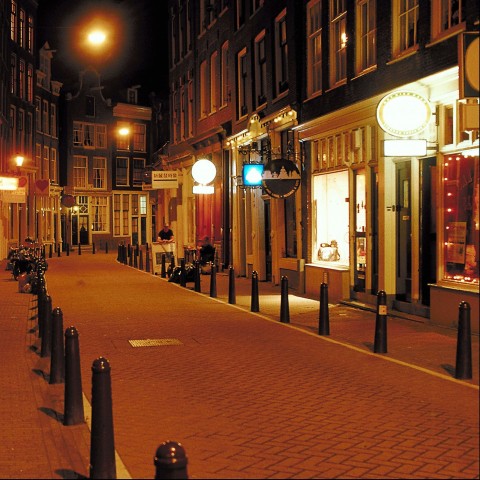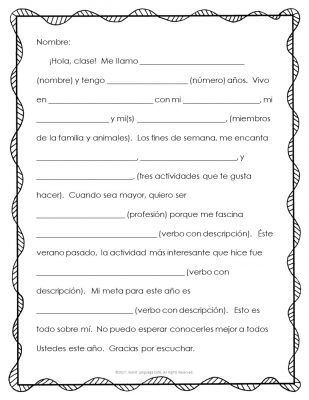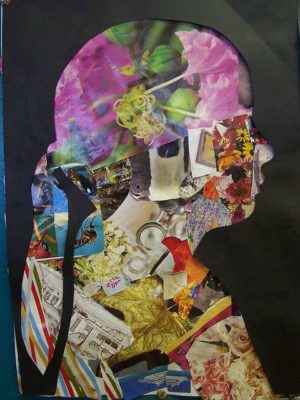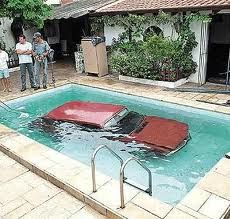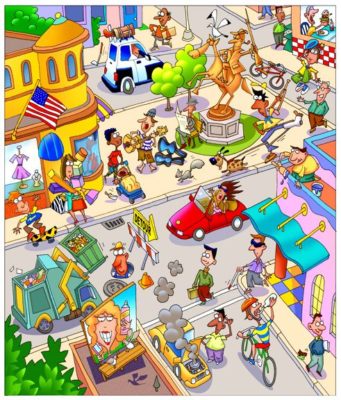Download Article
Download Article
Are you currently trying to type a word in Spanish when in your Microsoft Word program? This article will explain how to type Spanish letters into the program.
-
1
Open your Microsoft Word program.
-
2
Add the Spanish language to the list of recognized languages for input words. Open Tools menu from Menu bar, and select Language under the Set Language portion of the menu.[1]
Advertisement
-
3
Understand the process to type in words of Spanish that contain accent marks and miscellaneous lettered marks. You can either use the Alt key the Ctrl and the associated other key you’d like to add key methods to display the character.[2]
Advertisement
-
1
Ensure that Num ⇩ is currently enabled. Make sure the light on your keyboard for this key is currently lit. Press the Num ⇩ key, if it is not.
-
2
Know the letter you’d like to create.[3]
-
3
Locate the number that corresponds to the letter you’d like to use from Help with Microsoft Keyboards US-International table that lists all of the most-often typed characters for most any language that contains miscellaneous punctuation with letters.
-
4
Press and hold down Alt until further notice.[4]
-
5
Type the number you just previously learned from the page using the numbers on the number pad section of the keyboard only.
-
6
Release the Alt key, and the character should appear.[5]
Advertisement
-
1
Ensure that Num ⇩ is currently enabled. Make sure the light on your keyboard for this key is currently lit. Press Num ⇩ if the light has not been lit yet.[6]
-
2
Know the letter you’d like to create.[7]
-
3
Press and hold down Ctrl until further notice.
-
4
Press the ' character once. Pressing this key will trigger Word to use the characters with the apostrophe on top of the letter.[8]
-
5
Press the letter you’d like to enter that contains the apostrophe on top of it. (It will even work, if you type an uppercase letter instead.)[9]
-
6
Release the Ctrl key.
Advertisement
-
1
Press and hold down the Ctrl+Alt+⇧ Shift until further notice.
-
2
Press the ? or ! on your keyboard.
-
3
Release all the buttons at once.
Advertisement
Add New Question
-
Question
How do I write the accents in Spanish?
I think you mean the accents? For é ó ú á í you just hit alt and grave at the same time as the letter Otherwise you go to Symbol, find the symbol you want to use and insert it. Once you’ve used it, a letter will come up in the top list of symbols so you don’t need to continually scroll down through them to find it.
Ask a Question
200 characters left
Include your email address to get a message when this question is answered.
Submit
Advertisement
Thanks for submitting a tip for review!
Things You’ll Need
- Microsoft Word
- Spanish translated text ready to be used
- Computer mouse and keyboard
References
About This Article
Thanks to all authors for creating a page that has been read 233,334 times.
Did this article help you?
Don’t miss out! Sign up for
wikiHow’s newsletter
Subscribe
You’re all set!

By
Last updated:
December 6, 2022
Do you want to improve your Spanish writing skills and get even closer to fluency?
If you want to make Cervantes blush with your mastery of Spanish writing, you have come to the right place.
This step-by-step guide will give you the tools to write practically anything in Spanish, and show you why writing is not only important, but also fun and easy.
Contents
- Spanish Writing for Beginners
- How to Write in Spanish
-
- How to write letters in Spanish
- How to write an email in Spanish
-
- Greeting
- Reason for writing
- Body
- Closing
- How to write an essay in Spanish
-
- Giving your opinion
- Agreeing and disagreeing
- Backing your claims
- Conclusion
- Texting in Spanish
- Spanish creative writing
- Journaling in Spanish
- Other types of Spanish writing
-
- Recipes
- Greeting cards
- Notes
- How to Type in Spanish
-
- Main differences between English and Spanish keyboards
-
- Accent marks
- Question and exclamation marks
- Symbols
- Key Spanish Writing Rules
-
- Spanish spelling
- Capitalization rules in Spanish
- Spanish punctuation
- Spanish sentence structure
- Spanish abbreviations
- Other differences between English and Spanish writing rules
Download:
This blog post is available as a convenient and portable PDF that you
can take anywhere.
Click here to get a copy. (Download)
Spanish Writing for Beginners
Many beginner learners of Spanish have a tendency to ignore writing at the beginning of their language journey.
Writing is one of the four major language skills (together with speaking, listening and reading), and it is equally important to practice it if you want to reach fluency.
There are several reasons why a beginner should start practicing writing in Spanish from the very beginning:
- Writing helps you improve other language skills. When you write, you are using words (vocabulary), patterns and rules (grammar). Additionally, you are producing Spanish that you can later use in your Spanish conversations.
- Writing helps you remember. You will remember a word or a grammar rule more easily if you write it. Lots of words and constructions repeat themselves, so it will be hard to forget them.
- Writing boosts your spelling. You cannot see words when you talk, but when you read, all you see is precisely that. By practicing Spanish writing, you will become more familiar with words you normally use and will learn how to spell them correctly from the start.
- Writing can be cathartic. You might not be the greatest writer in the world (yet!), but journaling in Spanish will provide you with a safe space where you can pour out your feelings and emotions.
- Writing in Spanish is fun. Learning Spanish in general is fun. Writing in a foreign language will make your brain work harder. You will probably come up with ideas and sentences you would never say in your native language. So what? Just write them down and laugh at them! Your journey to fluency should be a fun ride if you want it to be successful.
All these reasons are great, but how does a beginner who has just started learning Spanish begin to write without getting overwhelmed?
Start simple!
That is, start by writing simple words. This will allow you to learn how to spell some basic vocabulary you will use often.
Write down fixed expressions like gracias (thank you) or buenos días (good morning). These expressions are used every day in every possible context, so they will come in handy.
Next, start using your basic vocabulary to create full simple sentences like:
Yo soy español. (I am Spanish.)
Mi mamá come pan. (My mum eats bread.)
El perro es grande. (The dog is big.)
We all started this way, even in our mother languages. You will be building sentences up as you learn more Spanish, so do not worry about this for the time being.
The first sentences you write should only include basic vocabulary, simple sentence patterns and just one or two tenses at most (preferably, the presente simple).
The more grammar rules and new vocabulary you learn, the longer and more elaborate sentences you will write.
A key concept in writing is practice.
Writing in Spanish is not something you learn once and you are done. You need to practice, and you need to do it often.
Fortunately, there are many available resources you can use to get your daily Spanish writing dose:
- Books and workbooks
- Online
- Apps
- Courses and MOOCs
In the meantime, let’s have a look at how to deal with different types of writing in Spanish.
How to Write in Spanish
As you advance in your language learning journey, you will probably have to start writing different kinds of texts.
Spanish, just as the majority of languages out there, has its own rules for different types of writing.
The following sections will teach you everything you need to know to get started.
How to write letters in Spanish
The first thing you need to do before starting to write a letter is to decide whether it has to be formal or informal.
This will have an impact not only on the body of the letter, but also (and especially) on the way you start and finish writing it.
There are a couple of well-established rules you should bear in mind when writing a letter in Spanish:
- Querido/a (Dear) is only used in informal letters, while Estimado/a (Dear) is the preferred form in formal ones.
- You normally use just the first name of the person you are writing to if the letter is informal (Querido Julián), but Señor (Mr.), Señora (Mrs.) or Señorita (Miss) and a surname if the letter is formal (Estimado Sr. González).
- Use tú (informal you) in the body of informal letters, but usted/ustedes (formal you singular/plural) in formal ones.
- When closing a letter, you can send Besos y abrazos (Hugs and kisses) in casual letters, but never in formal ones. Use Saludos (Regards) in semi-formal letters, and Cordialmente/Atentamente (Yours sincerely) in formal ones.
How to write an email in Spanish
Knowing how to write an email in Spanish is a skill you are going to need sooner or later, because email communication, especially in a professional environment, is something most of us have to on a daily basis.
The majority of the rules we had for writing letters also apply here.
You should make sure to use the right opening and closing in your email, and that the overall tone and the vocabulary used are appropriate to the situation.
When writing an email, especially a formal one, you will normally have to include four sections: greeting, reason for writing, body of the email and closing.
Here is a very brief example of an informal email John wrote to his friend Joanne:
Greeting
¡Hola, Joanne!
(Hi, Joanne!)
Reason for writing
Te escribo para preguntar si irás mañana al cumpleaños de Sonia.
(I’m writing to ask if you’ll be going to Sonia’s birthday tomorrow.)
Body
Me encantaría verte. ¡Hace tanto tiempo que no te veo! Madre mía, creo que la última vez que nos encontramos fue para Navidad. ¿Te acuerdas?
(I would love to see you. I haven’t seen you in ages! Good Lord, I think the last time we run into each other was on Christmas. Do you remember?)
Closing
Un abrazo,
(Hugs,)
John
How to write an essay in Spanish
Starting to write essays in Spanish is possibly one of the most challenging tasks for beginner learners.
Going from simple sentences to several paragraphs requires a lot of practice, but there are tons of fixed expressions that can be used in order to make this process easier.
Depending on the type of essay you need to write, you will have to cover one or more of the following points:
Giving your opinion
This is very common in essays, especially the ones included in official Spanish exams. Make sure you use expressions that help you introduce your personal opinions, such as en mi opinión (in my opinion), me parece que (it seems to me that) or creo que (I believe that).
Agreeing and disagreeing
Another very common type of essay is the one where you are given a sentence or quotation and you have to agree or disagree with it. Useful expressions here can be estoy de acuerdo (I agree), no estoy de acuerdo (I disagree) and es falso que (it is false that).
Backing your claims
If you say that something is false or that you know for a fact something is true, you should back your claims with some evidence. Try to introduce words and expressions such as según (according to), demostrar (to demonstrate) and la fuente (the source).
Conclusion
A conclusion normally summarizes the main topics of the essay and answers any questions and hypotheses that were posed in the introduction. When writing your conclusion, use expressions like en conclusión (in conclusion), por esta razón (for this reason) and en resumen (in summary).
Texting in Spanish
Texting in any language has its own separate set of rules.
For instance, depending on the recipient of the message, two texts can look completely different even if they include the exact same information:
Xq tki. (Because I have to go.) This is very informal, sent to a friend.
Porque tengo que irme. (Because I have to go.) This is sent in a much more formal situation, normally to someone with whom we do not have a very close relationship.
As you can see from the first example, there are a lot of abbreviations and slang words you can use while texting in Spanish, much like you would do in English.
It would be impossible to mention all of them here, but if you learn their most common traits, you will be able to text in Spanish like a pro:
- Letters are omitted. The most common feature you will see is the omission of vowels and consonants.
-
- For example: xa — para (for), gnl — genial (great)
- The letters q and c normally become k.
-
- For example: One of the most common examples is the expression tkm — te quiero mucho (I love you so much)
- There are some established abbreviations you will need to learn by heart. Sometimes you will only be given one letter, so knowing what it means in the world of Spanish texting will come in handy.
-
- For example: b — bien (good), q — que/qué (that/what)
- Numbers and symbols can also be used. Just as in English, if a number comes close to the pronunciation of a part of a word, some letters will be replaced by numbers.
-
- salu2 — saludos (regards), 100pre — siempre (always)
- Watch out for acronyms. Spanish normally uses their own versions of well-known acronyms. These acronyms are often similar to the international ones or can be understood from the context, but sometimes they will be completely different.
-
- For example: NATO — OTAN, World Health Organization / WHO – Organización Mundial de la Salud / OMS
Spanish creative writing
Creative writing is basically any kind of writing that is not professional, academic or journalistic.
Since this definition is so broad, there are also many types of writing that can fall into this category, the most common ones being poetry, novels, scripts, short stories, fairy tales and screenplays, among others.
Creative writing can be an amazing way to improve your Spanish language skills.
It forces you to think, be creative, ask questions and find answers for them. Your brain will be working hard while you write creatively, and the fact that you will be using vocabulary and grammar rules you have previously studied will make you remember them easier.
The ideal scenario for a learner of Spanish who wants to give creative writing a go would be having a native Spanish speaker that can read what the learner is writing and give detailed feedback (spelling and grammar errors and overall writing skills that could be improved).
Unfortunately, this is quite difficult to find, so the second-best option is to find resources that will help the learner get some Spanish writing practice (such as writing apps, creative writing websites, textbooks that teach writing, writing prompts, etc.).
Regardless of the way you choose to practice your creative writing skills, remember rule number one of every good writer: You have to read much more than you write!
Journaling in Spanish
Journaling is basically putting our thoughts and emotions into words.
It is a practice that helps many people cope with anxiety, depression or just their daily life and problems, and it becomes a safe space where the writer creates their own rules.
Since there are no established rules, journaling can be a good way of practicing writing in Spanish without stress. No one except you will have access to your journal (unless you want to), so it does not matter if you make spelling mistakes or write grammatically incorrect sentences as long as you are doing it in Spanish.
If you feel that writing a journal in Spanish can be challenging, try to break your thoughts down into smaller thoughts.
There are many topics you can write about that will allow you to practice your Spanish writing skills in an undemanding way:
- Your bucket list.
- Your dreams.
- Things you are thankful for.
- Reasons for learning Spanish.
- Things that motivate you.
- Things that make you sad.
- Your goals for this week/month/year.
- Your fears.
- Your favorite places/people and why.
The list goes on and on. Write about the topics you want, whenever you want and however you want. Just remember to do it on a daily basis to be able to enjoy all the benefits journaling in Spanish can bring to you, both mentally and linguistically speaking.
Other types of Spanish writing
There are many more types of Spanish writing, and each of them has its own intrinsic characteristics and rules.
Mentioning all of them would be impossible here, so here you have a selection of a few of them:
Recipes
Recipes have a very easy structure: a list of ingredients and steps to cook the dish. You can start practicing writing recipes in Spanish by using the infinitive when you give the instructions (Pelar las patatas — To peel the potatoes), and move on to the imperative mood when you study the Spanish imperativo (Pela las patatas — Peel the potatoes).
Greeting cards
Even though we normally buy ready-made cards, adding a few words of our own could be a very nice finishing touch. If you are giving a birthday card, remember to include some wishes like ¡Feliz cumpleaños! (Happy birthday!) or ¡Te deseo mucha felicidad! (I wish you lots of happiness!). If you want to give a Valentine’s Day card, try to make it even more personal by creating a romantic card in Spanish yourself. Do not forget to express your feelings with phrases like:
- Mi amor (My love)
- Mi cariño (My sweetheart)
- Te amo (I love you)
Notes
Notes can be written to say thank you, to ask for a favor or to remind someone to do something. They tend to be very short and to the point, including only information that is absolutely necessary. For this reason, many notes only include one or two words:
- ¡Gracias! (Thanks!)
- Para ti. (For you.)
- ¿Me echas una mano? (Will you help me?)
- Te quiero. (I love you.)
- Que aproveche. (Enjoy your meal.)
- Compra leche. (Buy some milk.)
How to Type in Spanish
Spanish and English keyboards are different.
Because of that, typing in Spanish can be a challenge for the first few times.
There are several ways in which you can type in Spanish on your device:
- You can install a keyboard on your device.
- You can use Alt codes (Windows) and Opt codes (Macs).
- You can use online tools such as TypeIt.
If you take a look at a Spanish keyboard, you will notice some letters, characters and symbols have changed, moved or disappeared.
Let’s have a look at these changes.
Main differences between English and Spanish keyboards
Once you have your device ready to type in Spanish, you will notice some things are… different.
There are enough differences between a Spanish and an English keyboard to write a whole book, so I will only mention the three most important ones:
Accent marks
Spanish vowels can have an accent mark (á, é, í, ó, ú). In order to type it, your first have to type the accent key on your keyboard (‘) and then the vowel you want to add the accent mark to.
Another letter with a mark is the Spanish letter ñ. In this case, you only have to press the (:) key, because Spanish keyboards have their own ñ key. The last mark you will need in Spanish is the diéresis (¨). In order to type it, press Shift + the (‘) key. Then type u or i.
Question and exclamation marks
One of the first interesting facts we learn about the Spanish language is that it has opening question and exclamation marks.
In order to type the opening question mark, press Shift and (=). The closing question mark can be typed by pressing Shift and (-). As for the exclamation marks, the opening one is very easy: just press the (=) key. The closing one can be typed by pressing Shift + 1, like on your normal keyboard.
Symbols
Another change you will notice when typing in Spanish is the series of symbols you get by pressing Shift + numbers 2 to 0. Your keyboard probably has the sequence @#$%^&*(), while the Spanish keyboard will give you “·$%&/()=.
There are other differences between both keyboards, like the position of hyphens, dashes, apostrophes, colons, semi-colons, stops and commas, among others.
In the beginning, all these differences can be a little bit overwhelming, and you will probably type the wrong symbol or letter because your brain will want to do it automatically in your normal keyboard layout.
As with everything, practicing Spanish typing will be the key (no pun intended) to get you used to the new layout. There are even Spanish typing games where you can practice all you want until you feel fully comfortable using the Spanish keyboard.
Key Spanish Writing Rules
Every language has a set of writing rules that decide how a piece of written or typed text looks like.
Even though some rules seem to be almost universal (like the first letter of a sentence being capital), others vary from language to language.
If you want to be the next Cervantes, you should get acquainted with the main Spanish writing rules and the major differences between writing in English and writing in Spanish.
Below are a few of them.
Spanish spelling
Spelling is probably the most important feature to consider when writing in any language.
We need to know how to write a word correctly so that the reader understands us.
Spanish spelling is definitely easier than English spelling since we normally write and pronounce the words in the exact same way, i.e. each sound normally corresponds to a single letter and vice versa.
However, there are a couple of spelling “situations” that can give you a bit of a headache if you do not pay attention:
- The letter h has no sound. Regardless of its position in a word, it will always be soundless (zanahoria — carrot, hoguera — bonfire, hueso — bone). This letter changes the sound of the letter c when they go together (chaleco— vest, coche — car, noche — night), and even though it has no sound, it can change the meaning of a word (ola— wave, hola — hello).
- There are some couples of letters that can be confusing. It would be impossible for you to learn every word containing these pairs, so the best you can do is check a dictionary in case of doubt. The letters that normally cause problems to learners of Spanish are b/v, r/rr, g/j, ll/y and the “triplets” c/k/q and c/s/z.
- Spanish uses accent marks. Accent marks may be small, but they are very important. If a word has an accent mark in Spanish, do not ignore it, because accent marks can easily change the pronunciation and meaning of words (tráfico— traffic, trafico — I smuggle, traficó — he smuggled).
If you want to improve your Spanish spelling skills, you can try some Spanish spelling games. They will make the learning process much more enjoyable, and the topic more accessible to you.
Another option is the online language learning program FluentU—its quizzes are useful for practicing your spelling with questions where you need to type your answers.
The platform has authentic Spanish videos like movie clips and new segments that come with expert-written subtitles, so you get used to seeing the correct spelling of Spanish words. Save any word as a flashcard directly from the subtitles for a chance to practice it at your own pace.
Additionally, you may want to install a Spanish spell checker. This way you can be sure the majority of spelling errors you make while writing in Spanish will be detected and corrected.
Capitalization rules in Spanish
Spanish and English share many capitalization rules, but they also have some key differences.
Learning Spanish capitalization is actually pretty straightforward. You just have to remember the words that are not capitalized in Spanish.
For instance, Spanish does not capitalize, among others:
- Months
- Days of the week
- Languages
- Nationalities
- Religions and their adjectives
- Social and political movements
- The pronoun yo (I) unless it is the first word in a sentence
- Book titles (except for the first word)
- Movie titles (except for the first word)
- Personal titles (except when they are the first word in a sentence)
Spanish punctuation
Punctuation is another area where English and Spanish share a lot of features.
However, there are some Spanish punctuation rules that may be surprising for learners of Spanish.
These are the main ones (some of them have already been mentioned):
- Spanish has an opening question mark and an opening exclamation mark (¿,¡).
- Spanish does not capitalize the first word after a colon.
- Spanish uses the colon in the opening of letters. While English uses a comma (Dear Mrs. Petunia,), Spanish uses a colon (Estimada señora Petunia:).
- In Spanish, there is no Oxford comma at all. The last two items of a list will always be joined with a conjunction like y (and) or o (or).
- Spanish and English write out numbers differently. In Spanish, you use a period to separate groups of thousands (e.g. 1450 or 1,450 would be 1.450 in Spanish). Spanish uses the comma as the decimal separator (so 1.5 would be 1,5 in Spanish).
- Spanish normally leaves commas, periods and other punctuation marks outside the quotation marks. (English: “I love you.” vs. Spanish “Te quiero”.).
- Dialogue formatting is very different in Spanish. If you decide to write dialogues in Spanish, find a good Spanish dialogue resource first, because there are a couple of big differences in the way English and Spanish format their dialogues. The biggest difference is possibly the fact that Spanish uses a dash to open a dialogue (instead of quotation marks) and to enclose the dialogue tag (instead of commas). For example:
-
- English: “I love him,” she said, “I always have.”
- Spanish: –Lo amo –dijo ella–. Siempre lo he amado.
Spanish sentence structure
Sentence structure refers to the internal organization of a language, i.e. the order we have to put elements in a sentence so that it is grammatically correct.
Many learners of Spanish think that since both Spanish and English follow the general pattern S + V + O (Subject + Verb + Object), both languages build sentences in the exact same way.
This is true sometimes, as in the following two examples:
Marta está bebiendo café. (S + V + O)
Marta is drinking coffee. (S + V + O)
Unfortunately, this is not always the case, and learners of Spanish should take into account a couple of Spanish sentence structure rules if they want to come up with correct sentences, even if they are trying to produce basic Spanish sentences:
- In Spanish, you can omit the subject. If you know who you are talking or writing about, you do not need to mention that person (Tengo hambre — I am hungry). This is possible because verbs in Spanish have a different ending for each grammatical person.
- Adjectives come after the noun in Spanish. There are a few exceptions with a change in meaning, but overall, adjectives always come after the noun (la camisa blanca — the white shirt).
- Nouns and adjectives have to agree in Spanish. When you write a sentence in Spanish, you have to take a look at the nouns. Every determiner, quantifier, adjective and adverb that refers to a noun must have the same gender and number (el perro negro — the black dog, all words masculine and singular in Spanish; las tazas rojas — the red cups, all words feminine and plural in Spanish).
- Negation is very simple in Spanish. The majority of sentences become negative in Spanish by adding no in front of the main verb. No other changes are normally needed. You can also make negations in Spanish by using negative adverbs like nunca (never) and nadie (no one).
Spanish abbreviations
Abbreviations can be used in both formal and informal contexts, and even though they tend to work similarly across languages, there are a couple of things you should know about Spanish abbreviations and how to use them when writing in Spanish:
- Even though personal titles are not capitalized when written in full, their abbreviations are capitalized. For example:
-
- señor — Sr. / Mister
- señora — Sra. / Mrs.
- doctor — Dr. / Doctor
- There are some abbreviations that appear very frequently in Spanish correspondence. For instance:
-
- usted — Vd. / formal you
- se ruega contestación — S.R.C. / RSVP
- Ordinal numbers are gendered. They are adjectives, so they take on the gender of the noun they are referring to. Because of this, their abbreviations are also marked for gender (1º/1ª, 2º/2ª…).
- Spanish abbreviations can have a plural form. Normally, abbreviations add -s to form their plural (página — pág. / page, páginas — págs. / pages). If the abbreviation has only one letter, they normally double it (página — p. / page, páginas — pp. / pages).
To the surprise of many learners of Spanish, the USA also has an abbreviation that has double letters because it is in the plural (Estados Unidos — EE. UU.).
- Some acronyms do not accept the plural ending -s. They will still take the plural determiner if necessary (los CD — the CDs). Oddly enough, you have to pronounce the final -s when reading/pronouncing them (los ce-dés — the cee dees).
- There are some international abbreviations and acronyms that have their own version in Spanish. Examples of this are:
-
- la UE — la Unión Europea / the EU (European Union)
- la ONU — la Organización de Naciones Unidas / the UN (United Nations)
- Spanish people use a lot of abbreviations when texting. (Have a look at the section on Texting in Spanish for more info.)
Other differences between English and Spanish writing rules
Although less important, there are some differences between English and Spanish you should take into account when writing in Spanish:
- We write dates differently. In Spanish, the order of writing the date is always day/month/year. So, while an American might read the date 02/07/2018 as February the 7th 2018, for a Spanish-speaking person it would be July the 2nd 2018.
- We use different measurement systems. This is something to bear in mind not only while writing, but when using Spanish in general. Not everybody knows what inches, feet, pounds or miles are (especially in Spain). Spanish-speaking countries use the metric system, so we have centimeters, meters, kilograms, kilometers, etc.
I know this is a lot of information to digest, but the good news is that you now have everything you need to know about writing in Spanish in one single place.
Writing in Spanish is one of those skills that tend to be overlooked by beginners.
However, writing is one of the four major language skills, so it is advisable to start practicing it as soon as possible.
Thanks to writing, you will improve not only your vocabulary and grammar, but also your reading, speaking and listening skills.
So take a pencil and a piece of paper (or run that word processor you normally use) and start writing in Spanish right away.
Stay curious, my friends and, as always, happy writing!
Word Order
Spanish is more flexible than English is with word placement
Roberto estudia. (Roberto is studying.).
Tom Merton/Caiaimage/Getty Images
The subject of word order in Spanish can be quite complex, so this lesson should be considered merely an introduction. As you study Spanish, you will encounter a wide variety of ways of ordering words in a sentence, many of them ways that are impossible or awkward in English.
In general, Spanish is more flexible with its word order than English is. In both languages, a typical statement consists of a noun followed by a verb followed by an object (if the verb has an object). In English, variations from that norm are used mostly for literary effect. But in Spanish, changes in the word order can be heard in everyday conversation or seen frequently in everyday writing such as that found in newspapers and magazines.
Typical Word Orders
The chart below shows examples of some common ways of ordering words. Note that in many sentences the subject can be omitted if it can be understood from the context. As a beginning student, you don’t need to memorize these word-order possibilities, but you should be familiar with these common schemes so you don’t trip over them when you come across them.
| Type | Order | Example | Comment |
| Statement | Subject, verb | Roberto estudia. (Roberto is studying.) | This word order is extremely common and can be considered the norm. |
| Statement | Subject, verb, object | Roberto compró el libro. (Roberto bought the book.) | This word order is extremely common and can be considered the norm. |
| Statement | Subject, object pronoun, verb | Roberto lo compró. (Roberto bought it.) | This word order is extremely common and can be considered the norm. Object pronouns precede conjugated verbs; they can be attached at the end of infinitives and present participles. |
| Question | Question word, verb, subject | ¿Dónde está el libro? (Where is the book?) | This word order is extremely common and can be considered the norm. |
| Exclamation | Exclamatory word, adjective, verb, subject | ¡Qué linda es Roberta! (How beautiful Roberta is!) | This word order is extremely common and can be considered the norm. Many exclamations omit one or more of these sentence parts. |
| Statement | Verb, noun | Sufren los niños. (The children are suffering.) | Placing the verb ahead of the noun can have the effect of placing more emphasis on the verb. In the sample sentence, the emphasis is more on the suffering than who is suffering. |
| Statement | Object, verb, noun | El libro lo escribió Juan. (John wrote the book.) | Placing the object at the beginning of the sentence can have the effect of placing more emphasis on the object. In the sample sentence, the emphasis is on what was written, not who wrote it. The pronoun lo, although redundant, is customary in this sentence construction. |
| Statement | Adverb, verb, noun | Siempre hablan los niños. (The children are always talking.) | In general, Spanish adverbs are kept close to the verbs they modify. If an adverb starts a sentence, the verb frequently follows. |
| Phrase | Noun, adjective | la casa azul y cara (the expensive blue house) | Descriptive adjectives, especially ones that describe something objectively, usually are placed after the nouns they modify. |
| Phrase | Adjective, noun | Otras casas (other houses); mi querida amiga (my dear friend) | Adjectives of number and other nondescriptive adjectives usually precede the noun. Often, so do adjectives being used to describe something subjectively, such as to impart an emotional quality to it. |
| Phrase | Preposition, noun | en la caja (in the box) | Note that Spanish sentences can never end in a preposition, as is commonly done in English. |
| Command | Verb, subject pronoun | Estudia tú. (Study.) | Pronouns are often unnecessary in commands; when used, they nearly always immediately follow the verb. |
Sample Sentences Demonstrating Spanish Word Order
The sentences below are examples of Spanish as it is most commonly ordered:
La atención a los recién llegados es un reto para las Fuerzas de Seguridad. (Attention to the recently arrived is a challenge for the Security Forces. Here the word order is almost to what you would find in English.)
Diagnostican por error una gripe a una joven y terminan amputándole la pierna. (They diagnosed the flu by mistake in a boy and ended up amputating his leg. Here the phrase por error, meaning «by mistake,» is kept closer to the verb, diagnostican, than it would be in English.)
Un coche blanco será más fresco en verano. (A white car will be cooler in summer. The adjective blanco, meaning white, comes after the word for car, coche, not before.)
¿Dónde están las oportunidades? (Where are the opportunities? In simple questions, English and Spanish word order can be identical.)
Es importante que me diga con quién saliste. (It is important that you tell me who you left with. The pronoun object me, «me» in English, comes before diga, «you left,» the reverse of English. And while the English sentence ends with the preposition «with,» in Spanish con must come before the word here for «who,» quién.)
Key Takeaways
- Although word order in Spanish is often similar to that of English, Spanish can be more flexible.
- Among the key differences are that descriptive adjectives usually follow nouns, and Spanish sentences cannot end in a preposition.
- Spanish adverbs usually are placed next to or very close to the words they modify.
A lot of Spanish words have accent marks – the small diagonal lines, which appear over certain letters when written down – are one of the most instantly notable features of the Spanish language. However, understanding when and where to use them can seem like a daunting task, especially if you are a novice.
Fortunately, there are a few key rules which govern the use of accent marks and stresses within Spanish. That means that, once you understand and learn them, this seemingly confusing aspect of the language suddenly makes a whole lot more sense, and you will have a far greater understanding of how pronunciation works.
Start your journey to reach fluency
Spanish accent marks explained
What is a written accent?
Accents, sometimes known as ’tildes’, appear at the top of certain letters in Spanish, and are written as a short diagonal line, from the top right to the bottom left. They can only ever appear over the five vowel letters (á, é, í, ó, ú), meaning you will never see a Spanish word with an accent mark over a consonant.
Written accents have three main functions within the language. The first is to separate words which would otherwise be spelled identically, the second is to signify questions, while the third (and perhaps most important) function is to help indicate which syllable of the word should be stressed, or emphasised, when spoken aloud.
The basics of word stress in Spanish
A stressed syllable can be broadly defined as a syllable that is given greater emphasis, relative to the other syllables around it. This may be signalled through pronunciation in several different ways, including increased vowel length, increased loudness, or a change in pitch. All Spanish words have at least one stress.
Within the Spanish language, stress is functional, meaning that the location of stressed syllables can alter the meaning of the words being spoken. For instance, the words célebre and celebré have different meaning – ‘famous’ and ‘I celebrated’, respectively – and pronunciation is separated only by the location of the stressed syllable.
Start your journey to reach fluency
Key rules of Spanish stresses
With regards to stressed syllables in Spanish, there are two key rules to remember:
1: If a word ends with a vowel, or the letters ‘s’ or ‘n’, the penultimate syllable is stressed.
2: If a word ends with a consonant other than ‘s’ or ‘n’, the final syllable is stressed.
Words where the penultimate syllable is stressed are said to be paroxytone and a total of 79.5 percent of all Spanish words fall into this category. On the other hand, words where the final syllable is stressed are said to be oxytone. Meanwhile, words which break these two rules, by having the stress on the third-to-last syllable are proparoxytone.
The word camino (path) ends in a vowel, so the penultimate syllable is stressed and it is paroxytone. The word animal (animal) ends in a consonant other than ‘n’ or ‘s’, so the final syllable is stressed and it is oxytone. Both of these words are in-keeping with the two key roles referred to above.
However, the word propósito (purpose) ends in a vowel, but breaks the rule, as the stress is on the third-to-last syllable [pro-PÓ-si-to]. It is, therefore, proparoxytone. This is where we start to see the use of written accents within the Spanish language, in order to mark the location of stresses.
When do you use accents in Spanish?
Once you get to grips with those two basic rules surrounding stresses in the Spanish language, the use of accent marks starts to make much more sense. Essentially, accents are used to indicate the position of the stress in words which break one of the two key rules mentioned above.
For example:
The word exámenes (exams) ends in an ‘s’, so according to rule #1, the stress should be on the penultimate syllable. Instead, the stress is on the second syllable, so an accent mark appears above the ‘a’.
The word compró (buy) ends in a vowel, so according to rule #1, the stress should be on the penultimate syllable. Instead, the stress is on the last syllable, so an accent mark appears above the ‘o’.
The word débil (weak) ends in a consonant other than ‘n’ or ‘s’, so according to rule #2, the stress should be on the last syllable. Instead, the stress is on the first syllable, so an accent appears above the ‘e’.
Now that you understand why they appear, you can start to view accent marks as a helpful pronunciation guide, rather than an alien concept. The important things to remember are that these accents can only appear above vowels, and they indicate the syllable which should be stressed in words which break the two basic stress rules.
Accent marks and homonyms
As stated earlier, a second main use of accent marks within the Spanish language is to help people to distinguish between words which have different meanings, but which would otherwise be spelled and pronounced identically. These words are known as ‘homonyms’ and these relationships are said to be ‘homonymous’.
Take a look at some of the most common homonymous words and look at how accents are used to separate them:
- mi (my) and mí (me)
- mas (but) and más (more)
- si (if) and sí (yes)
- solo (alone) and sólo (only)
- el (the) and él (he)
There are few rules to govern which types of words are given accents in Spanish in order to separate them from their homonyms, so you must simply learn them as different vocabulary. It is also worth noting that not all homonyms within the Spanish language are distinguished from one another through the use of accents.
Question words and accent marks in Spanish
Finally, accent marks are also used to denote question words within the Spanish language. To provide an example of this, the word ‘which’, when used as a connective word, is cual in Spanish. Yet, when the word ‘which’ is used as a question word (i.e. to mean ‘which?’), it is written as ¿cuál? instead.
The exact same pattern can be observed in other question words, as the following examples show:
- cuando (when) and ¿cuándo? (when?)
- donde (where) and ¿dónde? (where?)
- quien (who) and ¿quién? (who?)
So, to summarise, accent marks can help you to pinpoint the location of stresses within words, to understand which version of a homonym is being used, or to identify the presence of a question. They can, therefore, be viewed as a helpful guide for both pronunciation and comprehension purposes.
Start your journey to reach fluency
SingularGender of nouns in Spanish: masculineGénero femeninoEmployment
Noelia tells us about her business meeting.
RegularSingularGender of nouns in Spanish: masculineFamily & Relationships
Read this declaration of love from Enrique.
SingularGender of nouns in Spanish: masculineGénero femeninoMonuments, Tourism & Vacations
Borja is going to spend a week in Barcelona and tells us about the hotel that he is going to book.
SingularGender of nouns in Spanish: masculineEl PresenteFamily & Relationships
Marta and Andrew meet in a bar…
AdjetivoEl PresenteSingularFamily & Relationships
Guillermo tells us about a mysterious note he found inside his locker.
SingularGender of nouns in Spanish: masculineGénero femeninoMonuments, Tourism & Vacations
Travel with Enrique to Granada.
PluralNombreGénero femeninoPolitics, History & Economics
Learn about the purple tide in Spain.
SingularGénero femeninoGender of nouns in Spanish: masculineCelebrations & Important Dates
Humberto tells us about Christmas in Uruguay.
El PresenteGénero femeninoVerbos regulares -ar (presente)Monuments, Tourism & Vacations
César wants to get a train ticket to travel to Malaga.
El PresenteVerbo irregularSingularMonuments, Tourism & Vacations
Pedro and Miguel are visiting Atapuerca tomorrow.
Género femeninoPluralGender of nouns in Spanish: masculineLanguage & EducationTechnology & Science
Clara is using kwiziq for the first time and tells us about a lesson she is taking.
El PresenteSingularRegularFamous People
Learn about Alexis Sánchez, a famous soccer player.
SingularGénero femeninoPluralFamous PeopleLanguage & Education
Learn about Amelia Valcárcel, a famous Spanish philosopher.
AdjetivoEl PresentePluralArt & DesignFamous People
Marcos is going to a Frida Kahlo exhibition.
RegularSingularGender of nouns in Spanish: masculineArt & Design
Learn about this Argentinian flower.
AdjetivoGender of nouns in Spanish: masculineGénero femeninoCelebrations & Important Dates
Lucía’s mum tells us about her daughter’s costume.
PluralRegularSingularFamily & Relationships
Some friends are planning Ana’s baby shower.
RegularGender of nouns in Spanish: masculinePluralMusic
Learn about Arón Bitrán, a famous Chilean violinist.
Género femeninoRegularSingularSports & Leisure
Have you ever been to El Corte Ingles?
SingularRegularGender of nouns in Spanish: masculineFood & Drink
Raúl is having a refreshing cocktail in Majorca.
PluralGénero femeninoSingularFood & Drink
Sheila is at the nutritionist looking for a healthier lifestyle.
RegularEl PresenteAdjetivoMusic
Ana plans to go to the opera tonight.
SingularGénero femeninoGender of nouns in Spanish: masculineTechnology & Science
Marta and Javier love spending time in the lab.
El PresenteGénero femeninoPluralMonuments, Tourism & VacationsPolitics, History & Economics
Learn about Bank of Spain.
PreposiciónGénero femeninoSingularSports & Leisure
Mara tells us about exercising at the gym and its benefits.
PluralSingularGender of nouns in Spanish: masculineFood & Drink
Learn how to book a table in a Spanish restaurant.
SingularGender of nouns in Spanish: masculineGénero femeninoFood & Drink
Raúl loves having a healthy breakfast at home every morning.
El PresentePluralNombreMonuments, Tourism & Vacations
Learn about this cultural event in Buenos Aires.
Gender of nouns in Spanish: masculineGénero femeninoEl PresenteSports & Leisure
Learn about calva, a traditional Spanish game.
SingularPluralNombreCelebrations & Important Dates
Julio is in Rio de Janeiro to visit its famous carnival.
El PresenteVerbo irregularPronombre reflexivoArt & DesignMonuments, Tourism & Vacations
John would like to visit the Cathedral of Santiago de Compostela.
Gerundio/Spanish present participleSingularGender of nouns in Spanish: masculineCelebrations & Important Dates
Juan tells us his plans for New Year’s Eve.
PluralSingularNombreCelebrations & Important Dates
Patricia describes us the most common presents for Saint Valentine’s Day.
El PresenteAdjetivoVerbo irregularMonuments, Tourism & Vacations
Learn about Cibeles, a famous monument in Madrid.
Oración negativaPluralTiempo simpleTechnology & Science
Patricia doesn’t feel happy at all about climate change.
Gender of nouns in Spanish: masculineGénero femeninoSingularFamily & Relationships
Meet Coco, a lovely poodle.
RegularAdjetivoSingularFood & Drink
There is always a nice cup of Colombian coffee at Carlos Alberto’s house!
SingularPluralGender of nouns in Spanish: masculineArt & Design
Pedro tells us about a famous theatre building in Buenos Aires.
SingularGender of nouns in Spanish: masculineGénero femeninoFood & Drink
Patricia tells us about her favourite Cuban drink.
SingularGénero femeninoGender of nouns in Spanish: masculineSports & Leisure
Learn about cycle-ball, an exciting sport.
El PresenteVerbos con cambio ortográfico e > ie (presente)RegularSports & Leisure
Do you enjoy dreaming?
PluralSingularGender of nouns in Spanish: masculineCelebrations & Important Dates
María Isabel explains how Easter is celebrated in Ecuador.
El PresentePluralRegularFood & Drink
Are you able to appreciate a warm winter soup?
PluralGénero femeninoRegularFamous People
Discover famous people from Puerto Rico.
SingularGender of nouns in Spanish: masculinePluralCelebrations & Important Dates
Today is Father’s Day in Spain and some other countries.
Género femeninoSingularGender of nouns in Spanish: masculineCelebrations & Important Dates
Learn about this colourful Colombian festival which, despite its name, is best likened to a carnival with a plethora of exhibitions, activities and events taking place all over the city of Medellín.
SingularGénero femeninoGender of nouns in Spanish: masculineMonuments, Tourism & Vacations
Ramón is getting ready for his flight to Costa Rica.
El PresenteVerbos regulares -ar (presente)Adjetivo indefinidoLanguage & Education
Susana tells us about the importance of knowing languages at work.
El PresenteVerbo irregularGénero femeninoLiterature, Poetry, Theatre
Learn about this Spanish play by Lope de Vega.
Gender of nouns in Spanish: masculineSingularGénero femeninoTechnology & Science
Learn about the basics of the geography of Nicaragua.
SingularGender of nouns in Spanish: masculineGénero femeninoMonuments, Tourism & Vacations
Julio needs to go to the airport and explains how to get there.
AdjetivoSingularGender of nouns in Spanish: masculineMonuments, Tourism & Vacations
Fancy some luxury in Barcelona?
PluralGénero femeninoSingularFamily & Relationships
Learn about grandparents’ role in the Spanish economy.
SingularPluralNombreSports & Leisure
Federico is taking a challenge in order to raise money for children.
El PresenteSingularGender of nouns in Spanish: masculineCelebrations & Important Dates
Learn about Halloween night.
RegularSingularAdjetivoFilm & TV
Learn about a classic scary Halloween movie.
SingularGender of nouns in Spanish: masculineEl PresenteCelebrations & Important Dates
Marisa tells us about what she does for New Year’s.
SingularPluralGénero femeninoSports & Leisure
Autumn has just arrived in the northern hemisphere!
PluralRegularGender of nouns in Spanish: masculineMonuments, Tourism & Vacations
Could you afford to travel to space?
El PresenteAdjetivoVerbo irregularEmploymentFood & Drink
Antonio tells us about his job in a coffee shop.
El PresenteAdjetivoVerbo irregularFamily & Relationships
Clara is a Gemini and tells us about her personality.
SingularGender of nouns in Spanish: masculineGénero femeninoMusic
Meet Alejandro, a Mexican mariachi.
El PresentePluralGénero femeninoEmployment
Gabriel tells us about his volunteering work.
El PresenteSingularGénero femeninoTechnology & Science
Practise stem-changing, yo-go and modal verbs in the present tense.
El PresenteSingularGender of nouns in Spanish: masculineFamily & RelationshipsTechnology & Science
Lidia doesn’t really enjoy snowy weather.
El PresenteAdjetivoVerbo irregularFamily & Relationships
Ramiro introduces us his particular pet.
El PresenteGénero femeninoSingularSports & Leisure
Learn about Ana’s favourite summer hobby.
RegularPluralEl Futuro PróximoCelebrations & Important Dates
Soraya tells us about what she is going to do for Halloween.
Gender of nouns in Spanish: masculineGénero femeninoEl PresenteMusic
Learn about the most famous Spanish musical instrument during Christmas.
El PresenteSingularGénero femeninoTechnology & Science
Daniel likes surfing on the net everyday.
Género femeninoSingularGender of nouns in Spanish: masculineSports & Leisure
Sandra loves kickboxing, guess why!
El PresentePluralGender of nouns in Spanish: masculineFamily & Relationships
Denis tells us about his grandparents.
PluralRegularGénero femeninoFood & Drink
Learn about this famous Spanish supermarket.
SingularGender of nouns in Spanish: masculineGénero femeninoLanguage & Education
Meet José Luis, an Ecuadorian who speaks two languages.
El PresenteGender of nouns in Spanish: masculineGénero femeninoFamily & Relationships
Discover what present Jenifer wants to get for her birthday.
El PresenteVerbo irregularGénero femeninoImmigration & CitizenshipLanguage & Education
Meet Carmen, a woman who loves languages and international cultures.
SingularGénero femeninoGender of nouns in Spanish: masculineSports & LeisureFamily & Relationships
Roberto is spending a week in Norway with his family.
PluralSingularGender of nouns in Spanish: masculineLanguage & Education
Jose tells us about his school in Guatemala.
SingularAdjetivoGénero femeninoArt & Design
Discover Nora’s beautiful garden.
SingularGénero femeninoGender of nouns in Spanish: masculineEmployment
Igor is retired and feels very happy about living in a farmhouse in North Spain.
El PresenteSingularGender of nouns in Spanish: masculineEmployment
Look what Génesis thinks about her closest mailbox.
AdjetivoRegularEl PresenteTechnology & Science
Sonia describes how useful Instagram is for her.
SingularPluralNombreFamily & Relationships
Manuel wants to apologise to his father and promises to help him more with the housework.
SingularPluralGénero femeninoTechnology & Science
We are already in spring and our bodies know it!
SingularGender of nouns in Spanish: masculineGénero femeninoTechnology & Science
What’s the weather like in Seville today?
SingularPluralEl PresenteMonuments, Tourism & Vacations
Learn about Joyel Beach Campsite, a beautiful place to relax during the summer.
Gender of nouns in Spanish: masculineGénero femeninoPluralFood & Drink
Have you ever been to La Boqueria in Barcelona?
SingularRegularGender of nouns in Spanish: masculineSports & Leisure
María describes her favourite store.
SingularGender of nouns in Spanish: masculineGénero femeninoFood & Drink
Learn about lemonade, a typical summer drink.
SingularAdjetivoEl PresenteArt & Design
Carlos has a copy of Leonardo Da Vinci’s self-portrait at home.
El PresenteSingularGender of nouns in Spanish: masculineFamous PeoplePolitics, History & Economics
Learn about Letizia, queen of Spain.
Género femeninoSingularGender of nouns in Spanish: masculineFamous PeopleSports & Leisure
Marco’s favourite football player is Lionel Messi.
El PresenteGénero femeninoPluralFamily & Relationships
Although Lito is a deaf child, he is studying very hard to have a good job in the future.
Género femeninoSingularGender of nouns in Spanish: masculineSports & Leisure
Would you like to live in a tree?
SingularPluralGender of nouns in Spanish: masculineImmigration & Citizenship
María describes the main documents that are required to live in El Salvador.
PluralEl PresenteRegularMusic
Marina loves listening to Maná.
PluralRegularSingularMonuments, Tourism & Vacations
Discover Margarita Island, also called ‘the pearl of the Caribbean’.
Gender of nouns in Spanish: masculineGénero femeninoSingular
Leticia plans to meet her friends this evening.
Género femeninoSingularGender of nouns in Spanish: masculineFood & Drink
Learn about migas, a popular shepherd’s dish from Spain.
Género femeninoSingularGender of nouns in Spanish: masculineFamily & Relationships
Learn about Miguel’s family.
PluralNombrePreposiciónImmigration & CitizenshipTechnology & Science
Learn about the Military Emergencies Unit in Spain.
PluralSingularNombreSports & Leisure
Alberto tells us about starting mindfulness to combat insomnia.
PluralSingularAdjetivoArt & Design
Learn about Mudejar art in Aragon.
SingularGender of nouns in Spanish: masculineGénero femeninoFood & DrinkFamily & Relationships
Learn about Elisa’s aunt who is a baker.
El PresenteVerbo irregularRegularFamily & Relationships
Almudena introduces us to her best friend Juan.
El PresenteSingularGender of nouns in Spanish: masculineEmployment
Learn about Melisa’s business.
Género femeninoSingularGender of nouns in Spanish: masculineCelebrations & Important Dates
Arturo tells us about his Carnival costume.
Género femeninoGender of nouns in Spanish: masculineSingularFamily & Relationships
Practise reflexive verbs and some time expressions while learning about María’s daily routine.
PluralSingularEl PresenteFamily & Relationships
Meet Toby, an adorable dog.
RegularAdjetivoEl PresenteFilm & TV
Learn about Pablo’s favourite ad.
El PresenteGénero femeninoRegularMusic
David likes Christmas carols but he loves one in particular.
RegularAdjetivoSingularCelebrations & Important Dates
Mateo has his favourite Christmas jumper ready for the festive season!
AdjetivoEl PresenteRegularArt & Design
Andrea tells us about her favourite colour.
AdjetivoRegularSingularMusic
Marta tells us about her favourite Spanish song.
SingularGénero femeninoRegularFamily & Relationships
Learn about Miguel’s Paraguayan friend Juan.
AdjetivoEl PresenteRegularFamily & Relationships
Isabel is very proud of her granddaughters.
AdjetivoGénero femeninoGender of nouns in Spanish: masculineCelebrations & Important Dates
Susana tells us about her Halloween costume.
PluralEl Futuro PróximoSingularCelebrations & Important Dates
Marcos tells us about his upcoming Halloween party.
SingularEl PresenteAdjetivoLanguage & Education
Ashley tells us about her life in Spain.
AdjetivoEl PresentePluralArt & Design
Lucía tells us about her mother’s mobile phone.
PluralSingularEl PresenteFamily & Relationships
Danny introduces himself and says a little about who he is and what he does.
SingularPluralGender of nouns in Spanish: masculineFamily & Relationships
Lola introduces herself and says a little about who she is and what she does.
El PresenteSingularPluralFamily & Relationships
Learn about how Mateo uses his imagination to play.
SingularGender of nouns in Spanish: masculineGénero femeninoFamous People
Manuel’s neighbour is very famous.
SingularGénero femeninoNombreFamily & Relationships
Discover what Maite thinks of her neighbourhood while practicing stem-changing verbs and vocabulary for sports and activities.
SingularGénero femeninoGender of nouns in Spanish: masculineArt & Design
Sandra is very excited about her new couch!
SingularGénero femeninoGender of nouns in Spanish: masculineEmploymentSports & Leisure
Manuel tells us about his upcoming job as a lifeguard.
PluralRegularNombreTechnology & Science
Carlota tells us about her feelings towards social media.
Gender of nouns in Spanish: masculineGénero femeninoSingularSports & Leisure
Sara loves athleisure clothes and she uses Instagram to show her outfit of the day.
RegularAdjetivoGénero femeninoSports & Leisure
Rebeca is the owner of a private plane.
SingularGender of nouns in Spanish: masculineGénero femeninoLanguage & Education
Learn about Tamara’s school routine.
PluralGénero femeninoNombreLanguage & EducationTechnology & Science
Discover Pedro’s blog to learn Spanish.
PluralSingularAdjetivoCelebrations & Important DatesFamily & Relationships
Carmen is looking at her wedding album.
El PresentePluralSingularEmploymentTechnology & Science
Meet Jenaro, a dynamic science teacher who works remotely.
Género femeninoSingularGender of nouns in Spanish: masculine
Susana is very excited about her upcoming New Year’s party.
PluralSingularGender of nouns in Spanish: masculineMonuments, Tourism & Vacations
Tomás tells us about his journey back home after a long weekend.
SingularGénero femeninoGender of nouns in Spanish: masculineCelebrations & Important Dates
Pablo is attending Palm Sunday mass.
SingularRegularNombreSports & Leisure
Miguel loves playing Monopoly with his family.
El PresenteAdjetivoExpressing need and obligation (deber, tener que, haber que, necesitar [que])Sports & Leisure
Discover Sofia’s biggest passion: videogames.
RegularEl PresentePluralMonuments, Tourism & Vacations
Learn about this fair in Puebla.
PluralGender of nouns in Spanish: masculineGénero femeninoFamily & Relationships
Discover who the quarantennials are.
Gender of nouns in Spanish: masculineGénero femeninoSingularTechnology & Science
Inma is getting ready for a rainy day.
SingularGénero femeninoGender of nouns in Spanish: masculineFamous PeopleTechnology & Science
Meet Raquel Chan, a famous Latin American scientist.
PluralEl PresenteSingularSports & Leisure
Discover what Susana is reading at this moment.
PluralSingularGénero femeninoTechnology & Science
Learn some world recycling facts.
SingularGender of nouns in Spanish: masculineGénero femeninoFood & Drink
Learn about the Rioja Alavesa, a region famous for his wine.
SingularRegularPluralSports & Leisure
Raúl tells us about his favourite extreme sport.
SingularGénero femeninoGender of nouns in Spanish: masculineFood & Drink
Alejandro tells us about set lunch menus in Spain.
RegularGénero femeninoSingularFood & Drink
Take a walk around the supermarket with María!
PluralGénero femeninoSingularTechnology & Science
Susana uses smart bulbs at home to make her life easier.
PluralAdjetivoEl PresenteLanguage & Education
Gabriel’s dream is to become a language teacher.
RegularPluralSingularFood & Drink
Practise asking questions, expressing preferences, gender agreement and some useful basic food vocabulary.
AdjetivoEl PresenteRegularLiterature, Poetry, Theatre
Learn about this famous Spanish superhero.
PluralGender of nouns in Spanish: masculineAdjetivoSports & Leisure
Learn about Felipe’s favourite summer sport.
SingularPluralGender of nouns in Spanish: masculineTechnology & Science
See how people organise their rubbish in Spain.
Género femeninoSingularGender of nouns in Spanish: masculineTechnology & Science
Amanda tells us the advantages of teleportation.
SingularPluralGender of nouns in Spanish: masculineFamily & Relationships
Azucena is taking a test in a magazine.
Gender of nouns in Spanish: masculineRegularPluralMonuments, Tourism & Vacations
Ramiro plans to do the Camino de Santiago.
SingularPluralGénero femeninoPolitics, History & Economics
Learn about the flag of Honduras.
SingularGénero femeninoGender of nouns in Spanish: masculine
Discover the Florida park nativity scene in Vitoria.
SingularPluralRegularFilm & TV
Have you ever watched ‘The Great British Sewing Bee’?
Gender of nouns in Spanish: masculineGénero femeninoSingularLiterature, Poetry, Theatre
Learn about La Colmena, David’s favourite book.
PluralSingularGénero femeninoArt & Design
Discover this special building in Madrid.
Gender of nouns in Spanish: masculineGénero femeninoSingularCelebrations & Important Dates
Learn about the night of San Juan in Alicante, Spain.
El PresenteSingularGénero femeninoFamily & Relationships
Learn about the oldest man in the world. In this exercise you’ll practise El Presente, verb «gustar» and gender & number of nouns.
RegularAdjetivoPluralFamily & Relationships
Discover this power couple from 2022.
Expresiones para hablar del climaExpresión idiomática con «hacer»El PresenteTechnology & Science
Practise weather expressions.
Expresiones para hablar del climaSingularGender of nouns in Spanish: masculineTechnology & Science
Here’s today’s weather forecast for Santa Cruz de la Sierra in Bolivia.
RegularGénero femeninoSingularLiterature, Poetry, Theatre
Learn about 16th and 17th-century theatrical courtyards while practising El Presente, «qué», agreement of nouns and adjectives, and «para».
SingularGender of nouns in Spanish: masculineGénero femeninoMonuments, Tourism & Vacations
María is in Havana and has a list of things to do there.
PluralRegularGénero femeninoMonuments, Tourism & Vacations
Lucía has decided to stay home this summer.
Género femeninoSingularPluralPolitics, History & Economics
Did you know there are over 10,000 castles in Spain?
SingularPluralNombreFilm & TV
Gabriel plans to watch an Uruguayan film tonight.
Gender of nouns in Spanish: masculineGénero femeninoSingularCelebrations & Important Dates
Learn about the curse of Tuesday the 13th.
RegularGénero femeninoSingularFood & Drink
Find out why Raquel is vegan.
SingularGender of nouns in Spanish: masculineEl Futuro PróximoMonuments, Tourism & Vacations
Let Ana tell you about her plans while you practise El Futuro Próximo.
PluralSingularGénero femeninoCelebrations & Important Dates
María is excited about the arrival of the Three Wise Men.
Expresiones para hablar del climaExpresión idiomática con «hacer»Gender of nouns in Spanish: masculineTechnology & Science
Learn about what the weather is like in April.
Género femeninoGender of nouns in Spanish: masculineRegularEmployment
María describes how she is going to dress for a job interview.
AdjetivoRegularSingularFamous People
Guess who I am!
Género femeninoSingularGender of nouns in Spanish: masculineFamous PeopleFilm & TV
Do you know who Gloria Camila is?
El PresenteExpressing need and obligation (deber, tener que, haber que, necesitar [que])Expresión idiomática con «tener»Language & Education
Nacho needs to decide if he is going to study or work next year.
Órdenes y peticionesEl ImperativoPreposiciónFood & Drink
Celebrate the season in style with our special cocktail.
El ImperativoÓrdenes y peticionesPreposiciónFood & Drink
Enjoy a terrifying Halloween recipe!
SingularPluralAdjetivoMonuments, Tourism & Vacations
Manuel feels excited about his next cruise trip to Puerto Rico.
PreposiciónEl Pretérito IndefinidoVerbo irregularMonuments, Tourism & Vacations
Borja tells us about a relaxing day in Las Burgas.
El Pretérito ImperfectoAspecto imperfectivoVerbo irregularSports & Leisure
Julián tells us about his amazing weekend.
El Pretérito IndefinidoVerbo irregularAdjetivo indefinidoArt & Design
Carmela went to the beauty salon and tells us about her experience.
El Pretérito IndefinidoVerbos regulares -ar (presente)PreposiciónFilm & TVTechnology & Science
Javier watched a documentary about the Sun last night.
PluralRegularSingularMonuments, Tourism & VacationsCelebrations & Important Dates
David has booked a ghost tour for Halloween night in Madrid.
El Pretérito ImperfectoAspecto imperfectivoJerga/ Expresión idiomáticaMonuments, Tourism & Vacations
María describes us her unpleasant experience at a campsite.
El Pretérito ImperfectoEl Pretérito IndefinidoJerga/ Expresión idiomáticaFilm & TV
Marta watched a terrifying film yesterday.
El PresentePreposiciónVerbo irregularEmployment
Ainhoa is ready to do her first job interview.
El Pretérito PerfectoRegularVerbs in SpanishCelebrations & Important Dates
Alberto wrote a letter to Melchior, his favourite wise man.
El Pretérito IndefinidoEl Pretérito ImperfectoVerbos regulares -ar (presente)Monuments, Tourism & Vacations
Aurelia tells us about her luxurious visit to a friend in Marbella.
NombreSingularPluralFilm & TV
Carlos plans to have a movie marathon this weekend at home.
PreposiciónGénero femeninoNombreMonuments, Tourism & Vacations
Raquel received a postcard from her best friend.
AdjetivoSingularGénero femeninoLanguage & Education
Patrick tells us about his Spanish course in Colombia.
El Pretérito ImperfectoAspecto imperfectivoGénero femeninoSports & Leisure
Discover Antonio’s latest passion.
El Pretérito IndefinidoVerbo irregularEl Pretérito ImperfectoSports & Leisure
Two friends have been to a superbike event.
El Pretérito PerfectoVerbs in SpanishParticipioMonuments, Tourism & Vacations
Manuel tells us about his visit to Buenos Aires.
RegularEl Pretérito IndefinidoAdjetivo indefinidoFood & Drink
Discover Pedro and Maribel’s recipes for their barbecue.
Género femeninoSingularPreposiciónFamily & Relationships
Sara has to deal with a really noisy neighbour living downstairs.
El Pretérito IndefinidoNombreGénero femeninoFamily & Relationships
Discover what a wedding in Las Vegas means!
El Pretérito IndefinidoVerbo irregularRegularMonuments, Tourism & Vacations
Mercedes tells us about her weekend in Sierra Nevada in the south of Spain.
Género femeninoGender of nouns in Spanish: masculineNombreTechnology & Science
Learn about some interesting facts about the acid rain.
El Pretérito IndefinidoVerbos regulares -ar (presente)El PresenteFamous PeopleMusic
Learn about Ainhoa Arteta, a famous Spanish soprano.
PreposiciónEl Pretérito IndefinidoGénero femeninoFilm & TV
Learn about the Argentinian movie that Rodrigo saw yesterday.
El Pretérito IndefinidoVerbos regulares -ar (presente)RegularMonuments, Tourism & Vacations
María Elena spent an exciting afternoon with her friend Gabriela in Caracas.
GéneroPreposiciónNombreSports & Leisure
Discover what an aromatherapy session is like!
PluralNombreSingularFamous People
Learn about Juanes’ music with this interview.
El Pretérito IndefinidoVerbo irregularEl Pretérito ImperfectoMonuments, Tourism & Vacations
Juan tells us about his strange experience in a taxi. In this exercise you’ll practise El Pretérito Imperfecto and El Pretérito Indefinido.
Género femeninoGender of nouns in Spanish: masculineSingularMusic
Pilar tells us about her local dance, the Aragonese jota.
AdjetivoRegularPluralFamous PeopleFood & Drink
Minerva loves Zarauz and Arguiñano’s restaurant.
Género femeninoPluralNombrePolitics, History & EconomicsImmigration & Citizenship
Learn about The Spanish Armed Forces
El Pretérito IndefinidoVerbo irregularVerbos regulares -ar (presente)Art & Design
Learn about some art therapy exercises.
El Pretérito IndefinidoRegularEl Pretérito ImperfectoSports & Leisure
Gabriel just participated in a karate competition.
El Pretérito ImperfectoEl Pretérito IndefinidoRegularMonuments, Tourism & Vacations
Juan went to the beach with some of his friends yesterday.
NombreGénero femeninoGéneroFood & Drink
Are you looking for something different to eat? If so, visit Leila’s deli.
RegularGénero femeninoSingularSports & Leisure
Irene tells us about a circus afternoon with her son.
PluralRegularNombreFamily & Relationships
Raquel just left the dry cleaners with a lovely just-ironed shirt.
Gender of nouns in Spanish: masculineNombreGénero femeninoArt & Design
Marta is at the florist to buy her sister some flowers.
Género femeninoGender of nouns in Spanish: masculineSingularEmploymentSports & Leisure
Do you have a gym in your office?
Gender of nouns in Spanish: masculineGénero femeninoAdjetivoFood & Drink
Mónica and Raúl are at a restaurant next to the beach.
SingularGénero femeninoEl PresenteMonuments, Tourism & Vacations
Join Clara and her friend Isabel who travel to Zaragoza by train every weekend.
El Pretérito ImperfectoVerbo irregularSingularArt & Design
Learn about the Aztec culture.
El Pretérito PerfectoRegularParticipioArt & Design
Learn about some dressmaking techniques.
Verbo irregularEl Pretérito ImperfectoRegularFamily & Relationships
Renato has had a dream about being invisible.
Órdenes y peticionesEl ImperativoOración negativaTechnology & Science
Elena is getting some advice to avoid domestic accidents at home.
PluralPreposiciónGénero femeninoFood & Drink
How about a spectacular breakfast in Ibiza?
El Pretérito IndefinidoVerbo irregularRegularMonuments, Tourism & Vacations
Learn about this adventurous man who crossed the Amazon River in a canoe. In this exercise you’ll practise El Pretérito Perfecto, El Pretérito Indefinido and exclamative sentences with «qué».
El Pretérito IndefinidoEl Pretérito ImperfectoRegularCelebrations & Important Dates
Learn about a typical night in southern Spain.
El Pretérito IndefinidoParticipioVerbos regulares -er (presente)Food & Drink
Learn about Casa Madero, a winery in Mexico.
El Pretérito IndefinidoPreposiciónPor or Para?Art & DesignMonuments, Tourism & Vacations
Marcos went to see the cathedral of Santa Maria de Vitoria with his school.
El Pretérito IndefinidoVerbo irregularEl Pretérito ImperfectoFamily & Relationships
Maribel and her children enjoyed a beautiful shopping day at the mall.
Género femeninoSingularGender of nouns in Spanish: masculineLanguage & Education
Learn about other official languages in Spain.
El Pretérito IndefinidoEl Pretérito ImperfectoGéneroTechnology & Science
Learn about the discovery of color television.
NombreGender of nouns in Spanish: masculineGéneroArt & Design
Learn about how to use some colours in the kitchen.
PluralAdjetivoRegularSports & Leisure
Learn about some flowers growing in Costa Rica.
El Pretérito IndefinidoVerbo irregularEl Pretérito ImperfectoArt & DesignEmployment
Learn about this very unusual business.
NombreGender of nouns in Spanish: masculineEl Pretérito IndefinidoArt & DesignFamous People
Learn about Miguel’s favourite painter, Diego Velázquez.
NombreSingularGénero femeninoFood & Drink
Some statistics about diet in Latin American countries.
El PresentePreposiciónRegularTechnology & Science
Marta relies a lot on new technologies.
NombreGénero femeninoAdjetivoMonuments, Tourism & Vacations
Learn about Cusco, a famous Peruvian city.
RegularGénero femeninoGender of nouns in Spanish: masculineLiterature, Poetry, Theatre
Learn about the most famous Spanish novel.
NombreRegularGéneroFamous PeopleSports & Leisure
Learn about Donovan Carrillo, a Mexican figure skater.
El Pretérito IndefinidoRegularPreposiciónTechnology & Science
Lucas tells us about drought in his town.
NombrePreposiciónEl Pretérito IndefinidoMusic
Learn about the origin of drums.
Expressing desire (querer, gustar)Verbo modalAdjetivoLiterature, Poetry, TheatreTechnology & Science
What do you think of e-books?
AdjetivoRegularGénero femeninoFood & DrinkCelebrations & Important Dates
Mariela loves eating Easter cakes!
Género femeninoNombreSingularPolitics, History & Economics
Learn about Elizabeth II of Spain.
Gender of nouns in Spanish: masculineGéneroNombreFilm & TV
Learn about Jorge Javier, a famous TV presenter.
El PresentePluralVerbos con cambio ortográfico e > ie (presente)Sports & Leisure
Ester goes to the doctor because she feels unwell.
NombreEl Pretérito ImperfectoVerbos regulares -ar (presente)Art & Design
Learn about fashion influencers in social media.
PluralRegularNombreSports & Leisure
Almudena tells us about some fashion trends for this season.
El Pretérito IndefinidoEl Pretérito ImperfectoNombreArt & DesignFamous People
Learn some features about Francisco de Goya.
El Pretérito IndefinidoPreposiciónRegular
Inés tells us about her last visit to a fun fair.
Órdenes y peticionesEl ImperativoOración subordinada temporalFood & Drink
Fancy a fresh gazpacho?
Gender of nouns in Spanish: masculineGénero femeninoPluralFamous PeopleLiterature, Poetry, Theatre
Learn some lines from a written poem by Gloria Fuertes.
Gender of nouns in Spanish: masculineAdjetivoNombreEmployment
Manuel explains to us his work as a grape picker.
NombreGénero femeninoPluralCelebrations & Important Dates
Raquel tells us about her first Christmas in Mexico.
Género femeninoPluralRegularArt & Design
Rodrigo has brought home many handicrafts from Ecuador.
Género femeninoSingularPluralPolitics, History & Economics
Learn about the history of El Salvador.
PluralSingularGéneroArt & Design
Learn about some history of Latin American art.
PreposiciónNombreAdjetivoTechnology & Science
Learn about teenagers and their recommended sleeping hours.
Género femeninoSingularNombreTechnology & Science
Learn some tips to write a good blog.
El PresenteAdjetivoGender of nouns in Spanish: masculineEmployment
Learn about Sara’s company
AdjetivoVerbo irregularEl PresenteFood & Drink
Learn about this famous Spanish brand.
AdjetivoRegularPluralCelebrations & Important DatesFamily & Relationships
Sergio tells Daniel how much he loves him.
El Pretérito PerfectoParticipioVerbo irregularImmigration & Citizenship
Mariela just returned to her home country and she is very excited about it.
PreposiciónExpresión idiomática con «estar»Ser or Estar?Language & Education
Benito tells us about his most recent disappointment.
SingularGénero femeninoNombreArt & Design
Learn about the Icono Tower in Asuncion, Paraguay.
PreposiciónNombrePluralArt & Design
Learn about this beautiful exhibition in Barcelona.
El Pretérito ImperfectoEl Futuro PróximoNombreLiterature, Poetry, Theatre
Marian and her brother Manuel went to the theatre last night.
SingularGénero femeninoRegularTechnology & Science
Learn about the Indian summer in Spain.
NombreSingularEl Pretérito IndefinidoPolitics, History & EconomicsCelebrations & Important Dates
Celeste and her friends celebrated International Women’s Day in Madrid.
El Pretérito IndefinidoEl Pretérito ImperfectoVerbo irregularFamous PeoplePolitics, History & Economics
Learn about Joanna of Castile, a Spanish queen from the 15th-16th centuries.
El PresentePreposiciónPor or Para?Sports & Leisure
Learn about laughter therapy.
SingularGénero femeninoGender of nouns in Spanish: masculineMusic
Lucas tells us about how he is learning to play the guitar.
Pronombre indefinidoEl Pretérito IndefinidoVerbo irregularTechnology & Science
Saray feels that surfing the Internet is overwhelming.
SingularGénero femeninoGender of nouns in Spanish: masculineArt & Design
Susana tells us about a luxury mansion she saw in a catalogue.
El Pretérito IndefinidoVerbos regulares -ar (presente)Pronombre de complemento directoFamily & Relationships
Meet Manchitas, an adorable puppy from the animal shelter.
El ImperativoÓrdenes y peticionesRegular
Cook a delicious mangú with us!
Género femeninoNombreRegularFamous PeopleTechnology & Science
Learn about Maria Teresa Ruiz and her work in astronomy.
El ImperativoÓrdenes y peticionesModo imperativoFood & Drink
Learn how to prepare marzipan.
El Pretérito ImperfectoAspecto imperfectivoVerbo irregularMusic
Learn about Mecano, a famous Spanish band from the eighties.
Verbo irregularEl Pretérito ImperfectoEl Pretérito IndefinidoTechnology & Science
Mercedes tells us about the Mediterranean climate in southern Spain.
El PresenteNombreGénero femeninoSports & Leisure
Learn about the most famous Spanish card game.
PreposiciónPluralNombreFamily & Relationships
José is researching his family tree.
SingularRegularGender of nouns in Spanish: masculinePolitics, History & Economics
Daniela is feeling excited about getting her first home.
El PresenteGénero femeninoPronombreFamily & Relationships
Roberto wrote a letter of apology to his friend Marta.
Por or Para?El PresentePreposiciónFamily & Relationships
Learn about some fireplaces in little towns.
El PresentePreposiciónVerbos regulares -ar (presente)Technology & Science
Santiago loves having clean floors without any effort on his part.
El PresenteNombreGénero femeninoEmployment
Pedro tells us about his work as an astronaut.
AdjetivoGénero femeninoSingularFamily & Relationships
Carolina tells us about her mother’s mood.
Género femeninoNombreSingularEmployment
Ester just started a pension plan today.
El Pretérito IndefinidoJerga/ Expresión idiomáticaPreposiciónFamily & Relationships
Juan tells us about his sister’s birth.
Jerga/ Expresión idiomáticaEl Pretérito PerfectoNombreSports & Leisure
Magda tells us about her last spinning class at the gym.
El Pretérito ImperfectoVerbos regulares -ar (presente)Modo indicativoEmployment
Maribel finished her work experience a couple of weeks ago and tells us how it went.
AdjetivoEl PresenteAdjetivo posesivoSports & Leisure
Discover the best Zumba classes by Paula.
El PresentePreposiciónVerbos regulares -ar (presente)Technology & Science
Roberto works as a mystery shopper for several clothing stores.
PreposiciónAdjetivoÓrdenes y peticionesMonuments, Tourism & VacationsSports & Leisure
Learn about the Olive Culture Museum in south Spain.
RegularEl Pretérito IndefinidoPreposiciónSports & Leisure
Santiago loves going to the hills in summer.
El PresenteJerga/ Expresión idiomáticaVerbo irregularSports & Leisure
Learn about the benefits of playing video games.
PreposiciónPor or Para?El PresentePolitics, History & EconomicsTechnology & Science
Learn Spanish banking vocabulary.
Género femeninoPronombre de complemento directoEl Pretérito IndefinidoArt & Design
Sandra received two beautiful orchids for her birthday.
El Pretérito IndefinidoRegularGender of nouns in Spanish: masculineFood & Drink
Nothing tastes better than a homemade stew in cold winter!
NombreAdjetivoGéneroLanguage & Education
Peter describes his new Spanish teacher.
Gender of nouns in Spanish: masculineEl Pretérito IndefinidoRegularLiterature, Poetry, Theatre
Do you know who Pafman is? Learn about this Spanish superhero.
El Pretérito ImperfectoAspecto imperfectivoPluralSports & Leisure
Marta used to play with a paper fortune teller when she was a child.
Género femeninoPreposiciónEl PresentePolitics, History & EconomicsTechnology & Science
Learn about an alternative payment to cash.
El Pretérito IndefinidoVerbo irregularPronombre interrogativo y exclamativoFamily & Relationships
Bad day at work? You can always turn this situation around!
El Pretérito ImperfectoEl Pretérito IndefinidoAspecto imperfectivoMonuments, Tourism & Vacations
Practise El Pretérito Indefinido, El Pretérito Imperfecto and the position of pronouns.
El PresenteGénero femeninoNombreFilm & TV
Pablo tells us about his and his grandmother’s media preferences.
SingularGender of nouns in Spanish: masculineGénero femeninoFamily & Relationships
Sara loves remembering past times.
PreposiciónEl Pretérito IndefinidoGénero femeninoArt & Design
Learn about Ricardo Porro, a well-known Cuban architect.
Género femeninoNombreVerbo irregularArt & Design
Iker just visited a museum where he saw a painting by Velázquez.
NombreGénero femeninoGender of nouns in Spanish: masculineFamous PeopleLiterature, Poetry, Theatre
Learn about Rosario Castellanos, a feminist Mexican poet.
Género femeninoNombreGender of nouns in Spanish: masculineImmigration & Citizenship
Learn about a project that welcomes Sahrawi children in Spain every summer.
Género femeninoGender of nouns in Spanish: masculineSingular
Discover a healthy tradition to say goodbye to the year.
Género femeninoGender of nouns in Spanish: masculineSingularFood & Drink
José tells us about shopping at a local market in Sucre.
Gender of nouns in Spanish: masculineNombrePluralTechnology & Science
Miguel is explaining to Marcos how to recycle in Spain.
El Pretérito IndefinidoVerbos regulares -ar (presente)Modo indicativoFamily & Relationships
Elena seems to have recently found her soulmate!
El Pretérito IndefinidoVerbo irregularEl Pretérito PerfectoMonuments, Tourism & VacationsSports & Leisure
Maria and Luis love riding their bikes around Spain.
El Pretérito IndefinidoEl Pretérito ImperfectoRegularFamily & Relationships
Learn about this current housing phenomenon in Spain.
RegularAdjetivoNombreMusic
Learn about Tania León, a famous Cuban conductor.
El Pretérito ImperfectoVerbo irregularEl PresenteLiterature, Poetry, Theatre
Learn about Tartalo, a famous cyclops from the Basque Country.
El PresenteVerbos regulares -ar (presente)Verbo irregularFood & Drink
Ester and Sandra tell us about their favourite drink.
El Pretérito IndefinidoVerbo irregularVerbos regulares -ar (presente)Celebrations & Important Dates
Felipe tells us about his Thanksgiving dinner.
PreposiciónVerbo irregularExpressing desire (querer, gustar)Monuments, Tourism & Vacations
Learn about the city of Huelva and its beaches.
Género femeninoGender of nouns in Spanish: masculineSingularCelebrations & Important Dates
María tells us about a wonderful festival in Oaxaca, Mexico.
El PresenteEl Pretérito PerfectoExpresión idiomática con «tener»Family & Relationships
Susana describes her ideal partner.
AdjetivoSingularGénero femeninoMusic
Meet Luis Enrique Mejía, The Prince of Salsa.
PluralSingularNombreMonuments, Tourism & Vacations
Learn about the pyramids of Tikal in Guatemala.
El Pretérito IndefinidoVerbos regulares -ar (presente)Verbo irregularFood & Drink
Guadalupe loves when her roommate cooks fajitas.
El Pretérito PerfectoRegularParticipioCelebrations & Important Dates
Learn about the Spanish Christmas Lottery known as El Gordo.
Género femeninoNombrePluralArt & Design
Learn about The Zacatal Bridge in Mexico.
El ImperativoÓrdenes y peticionesRegularFood & DrinkCelebrations & Important Dates
Make a delicious Three King’s cake with our recipe.
Género femeninoNombreSingularSports & Leisure
Learn about the Peruvian toad in the hole game.
SingularNombrePluralFood & DrinkCelebrations & Important Dates
Learn about some traditional dishes for Carnival in Latin American countries.
El Pretérito IndefinidoVerbos regulares -ar (presente)El Pretérito ImperfectoMonuments, Tourism & Vacations
Macarena went on a balloon ride with her dad.
El PresentePor or Para?PreposiciónCelebrations & Important Dates
Halloween is here and waiting for you!
PreposiciónNombreRegularPolitics, History & Economics
Learn about Vasco Nuñez de Balboa, discoverer of the Pacific Ocean.
El Pretérito ImperfectoVerbo irregularModo indicativoEmployment
Nicolás and Mateo tell us about their work experience with elderly people.
Verbo irregularEl PresenteEl Pretérito IndefinidoSports & Leisure
Juan tells us about water polo, his favourite sport.
El Pretérito ImperfectoRegularEl Pretérito IndefinidoSports & Leisure
María tells us about her water-skiing experience.
RegularGénero femeninoEl Pretérito IndefinidoMonuments, Tourism & Vacations
Antonio tells us about his weekend in Barcelona.
El Pretérito IndefinidoVerbo irregularEl Pretérito ImperfectoCelebrations & Important Dates
Leandro tells us about what he did last halloween.
Género femeninoRegularSingularFamily & Relationships
Learn about the concept of emotional intelligence.
ParticipioEl Pretérito PerfectoVerbos regulares -er (presente)Monuments, Tourism & Vacations
Macarena needs to find the market in order to buy groceries for her mother.
El Pretérito IndefinidoAdjetivoRegularFilm & TV
Learn about this famous Spanish director.
PreposiciónPluralGender of nouns in Spanish: masculineCelebrations & Important Dates
Discover who will bring your Christmas presents in Spain this year.
Género femeninoSingularRegularPolitics, History & Economics
Have you ever wondered why the schedules in Spain are different compared to its European neighbours?
Órdenes y peticionesConjunción subordinanteGéneroEmploymentTechnology & Science
Discover some of the advantages of working remotely.
RegularPreposiciónPluralTechnology & Science
Rodrigo tells us his experience when working from home.
Verbs in SpanishParticipioConjunción subordinanteCelebrations & Important Dates
Here’s how World Book Day is celebrated in Catalonia.
El Pretérito IndefinidoEl Pretérito ImperfectoRegularFamous PeopleSports & Leisure
Learn about Yulimar Rojas, an excellent Latin American athlete.
El Futuro SimpleVerbos regulares -ir (presente)Verbos regulares -ar (presente)Technology & Science
Learn about the 5G network.
El Futuro SimpleVerbos regulares -er (presente)Verbos regulares -ir (presente)Celebrations & Important Dates
Eduardo is thinking about the 6th of January in order to get his Christmas presents.
El Pretérito ImperfectoJerga/ Expresión idiomáticaRegularMonuments, Tourism & Vacations
Rosa tells us about her bumpy flight to Costa Rica.
PronombreModo subjuntivoPronombre de complemento directoArt & Design
Marcos must wear a Christmas jumper (US: sweater) for a party, but he is not very excited about it.
El Futuro SimpleVerbos regulares -er (presente)Verbos regulares -ir (presente)Family & Relationships
Marisa tells us about her mother’s passion: dolphins.
Verbos regulares -er (presente)Verbos regulares -ir (presente)Verbos regulares -ar (presente)Celebrations & Important DatesFamily & Relationships
Javier tells us about what lunch on Easter Sunday is like for his family.
AdjetivoEl Futuro SimplePronombre de complemento indirectoArt & Design
Sara has received an invitation for a special event.
Pronombre de complemento indirectoPronombre de complemento directoPronombreCelebrations & Important Dates
Daniela tells us about her special Halloween wish.
El Condicional SimpleVerbos regulares (condicional)Pronombre de complemento indirectoMonuments, Tourism & Vacations
Andrea tells us about her ideal holiday.
PronombreEl Futuro SimplePronombre relativoMonuments, Tourism & Vacations
Stay in a top luxurious hotel in Madrid!
Pronombre de complemento directoEl Futuro SimplePronombre de complemento indirectoEmployment
Alberto is starting a new job next week in a hospital.
El Presente de SubjuntivoModo subjuntivoVerbos regulares -er (presente)Food & Drink
This food company has prepared a magnificent Mediterranean breakfast for you to start your day!
Pronombre de complemento indirectoPronombre de complemento directoPronombreFamily & Relationships
Manuela is asking Mateo to give their relationship a second chance.
El Pretérito ImperfectoModo subjuntivoJerga/ Expresión idiomáticaFamily & RelationshipsTechnology & Science
Learn about Tomás’s Tinder date.
El Presente de SubjuntivoModo subjuntivoEl Pretérito IndefinidoMonuments, Tourism & Vacations
Discover the beautiful city of Majorca.
El Pretérito ImperfectoEl Pretérito IndefinidoVerbos regulares -ar (presente)Sports & Leisure
Learn about the benefits of playing with video games.
Written accents in SpanishEl ImperativoGerundio/Spanish present participleArt & Design
Learn about Pedro, a high-skilled gardener.
AdjetivoArtículo definidoWritten accents in SpanishSports & Leisure
Learn about acupuncture in Spanish.
El Pretérito IndefinidoVerbo irregularVerbos regulares -ar (presente)Monuments, Tourism & Vacations
Raquel loves spending time with her friends and going on trips with them.
Adjetivo indefinidoVoz pasivaVerbo transitivoCelebrations & Important Dates
Learn about how All Saints’ Day is celebrated in Spain.
AdjetivoParticipioPronombre relativoFilm & TV
Discover As bestas, a Spanish thriller by the film director Rodrigo Sorogoyen.
Jerga/ Expresión idiomáticaEl Pretérito IndefinidoEl Pretérito ImperfectoMusic
María Fernanda went to a Carlos Baute’s concert, a famous Venezuelan singer.
Written accents in SpanishNombrePronombre de complemento directoEmploymentSports & Leisure
Maribel feels very excited about working as a group leader at a summer camp.
Written accents in SpanishTilde diacríticaPronombre indefinidoFood & Drink
Learn how to order some meat at the butcher’s.
Pronombre de complemento indirectoPronombre de complemento directoEl Presente de SubjuntivoSports & Leisure
Samuel wants to lose some weight and keep healthy.
El Pretérito IndefinidoVerbo irregularIrregulares en Indefinido/mismas terminacionesSports & Leisure
Pedro tells us about his workout at the local gym.
Pronombre impersonalVoz pasivaAdjetivoCelebrations & Important Dates
Ester plans to start the New Year at the Magic Fountain of Montjuïc.
Pronombre de complemento directoPronombre de complemento indirectoEl ImperativoFamily & Relationships
Lucia’s baby is not feeling well and she is at the pediatrician to get some advice.
AdjetivoAdverbio interrogativoAdjetivo indefinidoFood & Drink
Learn about the most famous street market in Madrid.
Pronombre de complemento indirectoTilde diacríticaPronombre de complemento directoMonuments, Tourism & Vacations
Mónica and Ángel are at the tourist office to get some information for their day trip to San Jose.
AdjetivoSuperlativoEl Condicional SimpleMonuments, Tourism & Vacations
Learn about this interesting tourism fair in Barcelona.
PronombreVoz pasivaPronombre de complemento directoArt & Design
Learn about the baroque in Latin America.
El ImperativoEl Futuro SimpleVerbo irregularPolitics, History & EconomicsTechnology & Science
Interested in exchanging your stuff without using money?
Pronombre de complemento indirectoGerundio/Spanish present participleNombreMusic
Learn about the Buena Vista Social Club, a famous Cuban band.
NombreGénero femeninoGéneroPolitics, History & Economics
This couple feels very excited about buying a house in Spain for their retirement.
El Pretérito IndefinidoVerbos regulares -ar (presente)El Pretérito ImperfectoLiterature, Poetry, Theatre
Ramiro tells us about Captain Thunder.
Pronombre de complemento indirectoEl Futuro SimplePronombre de complemento directoTechnology & Science
Learn about how to set up a cheap smart home.
El Pretérito ImperfectoPronombre de complemento directoPronombre de complemento indirectoSports & Leisure
Learn about Rodrigo, a high-speed motorcyclist.
Verbo irregularEl Pretérito IndefinidoWritten accents in SpanishMusic
Learn about classical music in Mexico.
Verbo modalGerundio/Spanish present participleAdjetivo demostrativoFamily & Relationships
Learn about coaching techniques to improve family relationships.
Tilde diacríticaWritten accents in SpanishPronombre de complemento directoFood & Drink
Mar really enjoys having a coffee in the morning.
El Futuro SimpleVerbos regulares -ir (presente)Verbos regulares -ar (presente)Monuments, Tourism & Vacations
Lucía has booked a holiday in Málaga.
AdjetivoJerga/ Expresión idiomáticaExpressing desire (querer, gustar)Celebrations & Important Dates
Learn about this famous festival in Cordoba.
El Futuro SimpleAdjetivoNombreSports & Leisure
Discover Darien National Park, a beautiful nature reserve in Panama.
El Pretérito IndefinidoVerbo irregularEl Pretérito ImperfectoCelebrations & Important Dates
Have you ever been to the Drag Queen gala of Gran Canaria?
Pronombre de complemento directoPronombre de complemento indirectoPronombre reflexivoTechnology & Science
Learn about the rain in the Basque Country, in northern Spain.
El Pretérito IndefinidoEl Pretérito ImperfectoGénero femeninoFamily & Relationships
Ester found a little treasure while she was cleaning her house.
NombreEl Pretérito IndefinidoGénero femeninoMusic
Learn about Dyango and his renamed song «Nostalgia».
Modo subjuntivoEl Presente de SubjuntivoExpressing desire (querer, gustar)Food & Drink
Do you like eating out?
El Futuro SimpleOración condicional con siEl PresenteMonuments, Tourism & Vacations
Discover Los Picos de Europa, a beautiful mountain range in northern Spain.
El Pretérito IndefinidoWritten accents in SpanishTilde diacríticaFamous People
Learn about Edgar Arandia, a Bolivian poet and painter.
El Pretérito IndefinidoGender of nouns in Spanish: masculineGéneroLiterature, Poetry, Theatre
Discover a famous poem by Miguel Hernández.
AdjetivoNombreGénero femeninoArt & Design
Learn about the meanings of the colour green.
El Pretérito IndefinidoVerbo modalPronombre de complemento indirectoFamily & Relationships
Learn about executive coaching.
Jerga/ Expresión idiomáticaVerbos regulares -ar (presente)Verbos regulares -er (presente)Music
Marisa loves Extremoduro and is looking forward to their next concert.
AdjetivoPronombre reflexivoPronombre de complemento directoTechnology & Science
Here’s one superhero who really enjoys flying!
El Futuro SimpleVerbos regulares -ir (presente)Verbos regulares -ar (presente)Family & Relationships
Do you need any fun ideas for baby shower games? Have a look at these ones!
Verbos regulares -ar (presente)El Futuro SimpleVerbos regulares -er (presente)Monuments, Tourism & Vacations
Discover Gandía beach on the Valencian coast.
El Futuro SimpleAdjetivoTilde diacríticaFood & Drink
Maria’s mother would like to visit this cheese factory in Spain.
El Futuro SimplePronombre de complemento indirectoPronombreTechnology & Science
Carolina tells us about her haunted house.
AdjetivoVerbos regulares -er (presente)Verbo irregularTechnology & Science
Paco is reflecting on this year’s health challenge.
Tilde diacríticaWritten accents in SpanishConjunción coordinanteCelebrations & Important Dates
Learn how Halloween means big business in different countries.
Pronombre de complemento indirectoAdjetivo indefinidoTilde diacríticaMonuments, Tourism & Vacations
Lisa is not sure whether to spend her holidays in the sun or in the snow.
Gerundio/Spanish present participlePreposiciónÓrdenes y peticionesCelebrations & Important Dates
Learn about Easter in Mexico.
El Futuro SimpleVerbos regulares -er (presente)Verbos regulares -ir (presente)Sports & Leisure
Juan Antonio tells us how to burn calories quickly.
GéneroGender of nouns in Spanish: masculineEl Presente de SubjuntivoFilm & TV
Estrella loves watching fun shows to have a good time.
Género femeninoGender of nouns in Spanish: masculineRegularSports & Leisure
Thomas tells us about his love for swimming and his hope to one day dive from up high!
El Futuro SimpleVerbos regulares -ar (presente)Verbos regulares -er (presente)Sports & Leisure
Andrés feels very excited about going ice climbing in southern Spain.
El Pretérito IndefinidoNombreGénero femeninoFamous People
Did you know that Ida Holz is one of the pioneers in computer science in Uruguay?
El Condicional SimpleTilde diacríticaWritten accents in SpanishArt & Design
Running out of ideas to organise your garden?
El Futuro SimpleTilde diacríticaGénero femeninoSports & Leisure
Marina tells us about her next motorcycle rally in Valladolid.
Pronombre de complemento indirectoPronombre de complemento directoAdjetivoFamily & Relationships
Meet Manuela, a woman in life with her life.
El Presente de SubjuntivoPreposiciónModo subjuntivoTechnology & Science
Learn about the Masaya Volcano in Nicaragua.
Pronombre relativoAdjetivoPronombre impersonalMonuments, Tourism & Vacations
Patricia tells us about spring in Chile.
AdjetivoGéneroGénero femeninoLanguage & Education
Learn about the different languages that exist in Honduras.
Pronombre reflexivoPronombre de complemento indirectoPronombreFamily & Relationships
Learn some useful tips for emotional intelligence.
AdjetivoVerbos regulares -ar (presente)ParticipioLiterature, Poetry, Theatre
Sonia tells about the last novel that she and her mother are reading.
PronombrePronombre de complemento directoPronombre reflexivoFamily & Relationships
Gabriela thinks she might have found love on the train.
Pronombre de complemento indirectoAdverbioAdjetivoCelebrations & Important DatesFamily & Relationships
Mercedes is thinking about telling her friend about her true feelings.
Verbos regulares -ar (presente)El Futuro SimpleVerbos regulares -er (presente)Sports & Leisure
Tania will soon be travelling to Machu Picchu with her sister.
El Pretérito IndefinidoEl Pretérito PerfectoJerga/ Expresión idiomáticaFamous PeopleSports & Leisure
Learn about Martín Fiz, a famous Spanish athlete.
Pronombre de complemento directoEl ImperativoPronombre de complemento indirectoFood & Drink
Learn about this refreshing summer dish.
Written accents in SpanishConjunciónTilde diacríticaPolitics, History & Economics
Learn about the military service in several Latin American countries.
El Futuro SimpleVerbos regulares -ir (presente)Verbos regulares -ar (presente)Sports & Leisure
Rosa is happy to start a mindfulness course at work.
Pronombre de complemento directoPronombre de complemento indirectoModo subjuntivoFamily & Relationships
Pedro takes good care of his skin.
Pronombre de complemento indirectoPronombrePronombre reflexivoFamily & Relationships
Ana tells us about her boyfriend Carlos.
AdjetivoEl Condicional SimpleGénero femeninoArt & Design
Isabel tells us about her dream house.
El Pretérito IndefinidoEl Pretérito ImperfectoPronombreSports & Leisure
Teresa had an odd dream last night.
El Condicional SimpleVerbos regulares (condicional)Verbo irregularArt & Design
Susana describes her ideal outfit.
AdjetivoGénero femeninoPronombre relativoArt & Design
Learn about this emblematic building in La Havana.
El Futuro SimpleVerbos regulares -ir (presente)Verbos regulares -ar (presente)Celebrations & Important Dates
Saúl tells us his New Year’s resolutions.
PronombreAdverbioVerbos regulares -er (presente)Technology & Science
Have you ever remained without an internet connection without notice?
El Pretérito ImperfectoAspecto imperfectivoPreposiciónSports & Leisure
Carlos tells us about open-air dances in Spain.
El Pretérito IndefinidoJerga/ Expresión idiomáticaPreposiciónMonuments, Tourism & Vacations
Mariana and Fabián travelled to The Andes in 2016.
ParticipioEl Pretérito PerfectoPronombre reflexivo
Ramón and Clara are in Punta Cana for their honeymoon.
El Pretérito IndefinidoAdjetivoNombreLiterature, Poetry, Theatre
Learn about Pablo Neruda, an extraordinary Chilean poet.
El Futuro SimpleVoz pasivaTilde diacríticaFood & Drink
Discover a wonderful place for wine lovers.
Verbos regulares -ir (presente)El Futuro SimpleVerbos regulares -er (presente)Sports & Leisure
Are you a fan of park workouts?
RegularAdjetivoGénero femeninoFamily & Relationships
Practise El Futuro Simple, El Pretérito Pluscuamperfecto and El Subjuntivo to express wishes, probability and to give negative commands.
Verbos regulares -ar (presente)El Pretérito IndefinidoEl Futuro SimpleCelebrations & Important Dates
Learn about the carnival of Tenerife.
Pronombre de complemento indirectoPronombre de complemento directoPronombre reflexivoMusic
Learn about this famous Spanish dance.
Pronombre reflexivoVerbos pronominalesGéneroFamily & Relationships
Learn about Paula and Bea’s relationship.
El Pretérito IndefinidoVerbos regulares -ar (presente)Pronombre relativoFamous PeopleTechnology & Science
Discover who Pedro Paulet was.
El ImperativoEl Presente de SubjuntivoÓrdenes y peticionesFood & Drink
Discover a classic Peruvian cocktail.
Pronombre de complemento directoPronombre de complemento indirectoPronombre reflexivo
Carlos tells us about hand drums in Jerez.
El Pretérito ImperfectoVerbos regulares -er (presente)Verbo irregularSports & Leisure
Learn about the traditional spinning top toy.
El Pretérito IndefinidoTilde diacríticaVerbos regulares -ar (presente)Art & Design
Isabel visited a pottery factory in north Spain.
El Futuro SimplePronombre de complemento indirectoVerbos regulares -er (presente)EmploymentLanguage & Education
Roberto dreams about becoming a firefighter.
PronombrePronombre de complemento directoPronombre reflexivoArt & Design
Learn about this spring flower.
Pronombre reflexivoPronombre de complemento indirectoPronombre de complemento directoImmigration & Citizenship
Irene tells us about her experience of being back home after having lived abroad for many years.
El ImperativoEl Presente de SubjuntivoÓrdenes y peticionesFood & Drink
Marisa tells us the recipe to cook Riojan-style potatoes for lunch.
Pronombre de complemento directoPronombre de complemento indirectoPronombre reflexivoTechnology & Science
Did you know that robots are used to help out with children at home?
El Pretérito IndefinidoPronombre de complemento directoRegularArt & DesignFamous People
Learn about Salvador Dalí.
AdjetivoGender of nouns in Spanish: masculineGénero femeninoFilm & TV
Discover why San Sebastian’s Film Festival is so famous in Spain!
El Pretérito IndefinidoPronombre relativoVerbo irregularMusic
Marcos enjoyed watching the sardanas when he visited Catalonia.
Pronombre de complemento directoWritten accents in SpanishAdverbio interrogativoSports & Leisure
Paco tells us about his favourite hobby.
AdjetivoJerga/ Expresión idiomáticaEl Futuro SimpleFamily & Relationships
Blanca loves singing with her family on Christmas day.
El Pretérito ImperfectoExpressing habits (soler vs tenses)Pronombre de complemento directoSports & Leisure
Marta tells us about some of her skiing memories.
El Condicional SimpleVerbos regulares (condicional)Aspecto imperfectivoTechnology & Science
Ana tells us about her last marketing class.
NombreGender of nouns in Spanish: masculineAdjetivoMusic
Learn about some traditional Spanish folklore.
Verbos regulares -ir (presente)ParticipioVerbos regulares -ar (presente)Music
Learn about the Spanish guitar.
Pronombre de complemento indirectoPronombre de complemento directoPronombreFamily & Relationships
Discover Mario’s tips to stay positive.
Jerga/ Expresión idiomáticaWritten accents in SpanishTilde diacríticaEmployment
Almudena is stuck on the traffic when gping to work.
Pronombre de complemento indirectoPronombre de complemento directoPronombreArt & Design
Discover why Maribel prefers to buy sustainable clothes.
AdjetivoNombreSuperlativoFood & Drink
Ingrid tells us about the specialties from her restaurant.
PronombreEl Presente de SubjuntivoModo subjuntivoMonuments, Tourism & Vacations
Pedro and Soraya are taking in the tourist sights of Madrid.
Jerga/ Expresión idiomáticaPronombre de complemento directoConjunción subordinanteMusic
Eugenia’s favourite dance is the tango.
Verbos regulares -er (presente)Verbos regulares -ir (presente)Verbos regulares -ar (presente)Food & Drink
Learn about some traditional Spanish food.
AdjetivoApócopeGénero femeninoSports & Leisure
Learn about the benefits of napping.
AdjetivoSuperlativoPronombre de complemento indirectoFood & Drink
Guillermo tells us about a very special type of coffee.
PluralSingularNombreMusic
Practice El Indefinido and El Imperfecto past tenses.
Written accents in SpanishTilde diacríticaEl Pretérito IndefinidoMonuments, Tourism & Vacations
Miguel tells us about Asunción, the capital city of Paraguay.
El Futuro SimpleVerbos regulares -er (presente)Verbos regulares -ir (presente)Monuments, Tourism & Vacations
How do you imagine the city of the future?
AdjetivoModo subjuntivoEl Condicional SimpleLanguage & Education
Peter reflects on his biggest difficulties when learning Spanish.
AdverbioPronombre de complemento directoPronombre reflexivoCelebrations & Important Dates
Discover why The Gate of the Sun is os popular for New Year’s Eve in Spain.
SuperlativoAdjetivoEl Futuro SimpleTechnology & Science
Manuela wants to use hashtags to promote her business online.
NombreGénero femeninoGéneroFamily & Relationships
Susana tells us about her new role as administrator.
El Futuro SimpleJerga/ Expresión idiomáticaEl PresenteTechnology & Science
Discover today’s horoscope for Gemini.
NombreGéneroPronombre relativoPolitics, History & Economics
Ramiro just read an article about economics.
El Presente de SubjuntivoModo subjuntivoPronombre relativoEmployment
Ramón is looking for the ideal employee for his company.
ConjunciónAdjetivoAdverbioMonuments, Tourism & Vacations
Did you know that the least polluted town is in Spain?
ConjunciónTilde diacríticaEl Pretérito ImperfectoLiterature, Poetry, Theatre
Learn about the milkmaid’s story.
Modo imperativoGerundio/Spanish present participlePronombre de complemento directoTechnology & Science
Learn about the origin of fire
Adverbio interrogativoWritten accents in SpanishPronombre relativoCelebrations & Important Dates
Do you really know the origins of Halloween? Find out here!
El Futuro SimpleVerbos regulares -ir (presente)Verbos regulares -ar (presente)Monuments, Tourism & Vacations
Learn about high-class Spanish hotels located in castles, palaces and other historic buildings.
Jerga/ Expresión idiomáticaPronombre de complemento directoAdjetivoSports & Leisure
Learn about the properties of thyme.
Adjetivo indefinidoAdjetivoGénero femeninoArt & Design
2023 seems to be the year of the restitution of looted art.
El Futuro SimpleGéneroVerbo irregularFood & DrinkTechnology & Science
Learn about this tasty tapas blog.
El Futuro SimpleVerbos regulares -ir (presente)Verbos regulares -ar (presente)Monuments, Tourism & Vacations
Rubén is dreaming about going on a cruise one day.
El Futuro SimpleEl Presente de SubjuntivoPronombre de complemento directoSports & Leisure
Learn about this famous game.
InfinitivoVerbos regulares (condicional)Oración subordinada temporalLanguage & Education
Amanda’s dream is to study at University of Panama.
AdjetivoJerga/ Expresión idiomáticaTilde diacríticaArt & Design
Discover this special bridge in the north of Spain which is also a UNESCO world heritage site.
Pronombre impersonalVoz pasivaVerbo transitivoFood & Drink
Learn about how to fight plastic pollution.
El Futuro SimpleEl Presente de SubjuntivoModo subjuntivoTechnology & Science
Mercedes welcomes us to her online store.
El ImperativoPronombre de complemento indirectoModo indicativoFamily & Relationships
Learn about different generations across the decades.
Jerga/ Expresión idiomáticaModo subjuntivoEl Presente de SubjuntivoCelebrations & Important DatesFamily & Relationships
Alejandra needs to find a good present for her father.
El Futuro SimpleVerbos regulares -er (presente)Verbos regulares -ir (presente)Technology & Science
Mario imagines what the Internet will be like in the future.
El Condicional SimpleGéneroGénero femeninoMonuments, Tourism & Vacations
Alma tells us about the city of Salamanca.
El Pretérito IndefinidoPronombre de complemento indirectoAdjetivoPolitics, History & Economics
Learn about the women’s right to vote in Mexico.
El Futuro SimpleVerbo irregularExpressing need and obligation (deber, tener que, haber que, necesitar [que])Food & Drink
Would you like to have your own cellar at home? Learn about it!
AdjetivoNombreModo subjuntivoCelebrations & Important Dates
Learn about this Mexican festival.
AdjetivoEl Pretérito ImperfectoParticipioArt & Design
Learn about Pablo Picasso’s self-portraits.
Pronombre de complemento indirectoReflexive verbsSe accidentalMonuments, Tourism & Vacations
Adela tells us about an axciting surprise she got from her boyfriend.
El Futuro SimpleModo subjuntivoVerbos regulares -er (presente)EmploymentLanguage & Education
Discover Vanessa’s career plans.
El Futuro SimplePronombre relativoEl Presente de SubjuntivoCelebrations & Important Dates
Daniela is wondering who wrote her an anonymous message.
El Pretérito ImperfectoEl Pretérito IndefinidoJerga/ Expresión idiomática
Tomás and his girlfriend saw a contortionist act that left them astonished.
Verbo irregularEl Futuro SimpleVerbos regulares -ir (presente)Monuments, Tourism & Vacations
Ana is furious about the fact that her train is delayed.
El Futuro SimpleVerbos regulares -er (presente)Pronombre de complemento directoArt & DesignCelebrations & Important Dates
Amalia plans to make her own costume for carnival.
Jerga/ Expresión idiomáticaAdjetivoPronombreFamily & Relationships
Sandra wrote a romantic letter to her love.
Pronombre de complemento indirectoPronombre de complemento directoPronombreCelebrations & Important Dates
Read this letter from my nephew.
Modo subjuntivoPronombre de complemento directoPronombre de complemento indirectoCelebrations & Important Dates
Rodrigo got lost during a celebration!
El Pretérito IndefinidoEl Pretérito ImperfectoWritten accents in SpanishMusic
Learn about Pablo Alborán and his excellent piano skills.
Jerga/ Expresión idiomáticaVoz pasivaAdjetivoCelebrations & Important DatesMusic
Jaime tells us about his experience in Seville during Easter celebrations.
El Pretérito ImperfectoEl Pretérito IndefinidoJerga/ Expresión idiomáticaTechnology & Science
Have you ever experienced a big snow storm?
El Pretérito IndefinidoEl Pretérito ImperfectoEl Pretérito Imperfecto SubjuntivoFood & Drink
Arancha enjoyed a special lunch today.
Jerga/ Expresión idiomáticaPronombre de complemento indirectoPronombreMonuments, Tourism & Vacations
Marta tells us about the pleasure of being in an empty city during the summer.
Gerundio/Spanish present participleAdjetivoEl Futuro SimpleFamily & Relationships
What does a true friendship look like?
El Pretérito ImperfectoEl Pretérito IndefinidoModo subjuntivoFamily & Relationships
Meet Beru the parrot. It’s hard to have a secret conversation with him around!
El Futuro SimpleAdjetivoEl Presente de SubjuntivoMonuments, Tourism & Vacations
Have a fun learning jorney with this tourist leaflet about the Guayas river in Ecuador.
El Pretérito IndefinidoEl Pretérito ImperfectoPronombre de complemento directoFamily & RelationshipsTechnology & Science
Carlos’ mum was concerned about his health and recommended him to spend a weekend away.
Pronombre de complemento directoPronombre reflexivoPronombre de complemento indirectoSports & Leisure
What do you think of a warm afternoon around the fire?
Pronombre de complemento indirectoEl Pretérito ImperfectoEl Pretérito IndefinidoFamily & Relationships
Carlos got an appointment with the Ear, Nose and Throat doctor to get a treatment for his anosmia.
Modo imperativoGerundio/Spanish present participlePronombre de complemento directoCelebrations & Important DatesTechnology & Science
Victoria is very excited about her upcoming online Carnival party.
Gerundio/Spanish present participleInfinitivoPronombre de complemento directoTechnology & Science
Lorena feels very lucky today with her online shopping gift voucher.
Pronombre de complemento directoPronombre de complemento indirectoEl ImperativoLanguage & Education
Learn how to write a formal letter of apology in Spanish.
InfinitivoGerundio/Spanish present participleJerga/ Expresión idiomáticaFamily & Relationships
Find out if you are ready to adopt an animal.
El Futuro SimpleEl Futuro PerfectoEl PresenteArt & Design
Learn about some art therapy exercises.
Jerga/ Expresión idiomáticaAdjetivoGerundio/Spanish present participleSports & LeisureTechnology & Science
Laura loves following social media athleisure accounts.
Pronombre de complemento indirectoPronombrePronombre de complemento directoArt & Design
Have you ever been to the Basque Pottery Museum?
El Presente de SubjuntivoPronombre de complemento indirectoModo subjuntivoCelebrations & Important DatesFamily & Relationships
Miguel is declaring his love for Jimena in front of everyone!
Pronombre relativoJerga/ Expresión idiomáticaAdjetivoFamous PeopleFilm & TV
Learn about the famous Spanish actress Blanca Suárez
AdjetivoPronombre de complemento indirectoWritten accents in SpanishFood & Drink
Discover why breakfast is such an important meal for performing well at work.
Pronombre de complemento indirectoInfinitivoPronombreMonuments, Tourism & VacationsSports & Leisure
Jesús and Mateo love their campervan and travelling around Spain
Pronombre de complemento indirectoModo subjuntivoPronombreMonuments, Tourism & Vacations
Get some fresh ideas for things to do when you go camping.
Jerga/ Expresión idiomáticaModo subjuntivoAdjetivoArt & Design
Adriana plans to attend an exclusive exhibition next year.
El Pretérito ImperfectoEl Pretérito IndefinidoModo subjuntivoFood & Drink
Rosa and Enrique tell us about their experience with this Chilean wine.
Written accents in SpanishInfinitivoTilde diacríticaArt & Design
María plans to change the clothes in her closet for the new season.
El Pretérito ImperfectoEl Pretérito IndefinidoExpressing ability (poder, saber)Food & Drink
Did you know that these lollipops were a Spanish invention?
AdjetivoParticipioPronombre relativoMonuments, Tourism & Vacations
Why is Colombia a great place to visit?
El Presente de SubjuntivoOración subordinada temporalAdjetivoMonuments, Tourism & Vacations
Learn about Couchsurfing, a service that connects a global community of travelers.
Pronombre de complemento indirectoPreposiciónModo imperativoMusic
Learn about the aurresku, a famous dance from the Basque Country.
Modo subjuntivoEl Futuro SimpleEl Presente de SubjuntivoArt & Design
Do some DIY with Marta!
Pronombre reflexivoPronombre de complemento indirectoPronombreSports & Leisure
Have you ever experienced a dream trip?
Pronombre de complemento indirectoPronombre de complemento directoWritten accents in SpanishMonuments, Tourism & Vacations
Learn about what driving looks like in Lima.
Pronombre de complemento indirectoGerundio/Spanish present participlePronombre de complemento directoFood & Drink
Agustín tells us about his delicious Easter empanadas from Chile.
AdjetivoEl PresenteParticipioTechnology & Science
In Spain, environmental fires are a big problem every summer.
Voz pasivaParticipioEl Pretérito IndefinidoTechnology & Science
Get to know Vitoria, European Green Capital 2012.
El Pretérito Imperfecto SubjuntivoModo subjuntivoInfinitivoMonuments, Tourism & Vacations
Have you ever heard about the wellspring of eternal love?
Adverbio interrogativoInfinitivoWritten accents in SpanishFamily & Relationships
Learn about family models in Spain.
Modo subjuntivoParticipioPronombre de complemento directoFilm & TV
Mariana is a big fan of the famous film Fast & Furious.
Modo subjuntivoInfinitivoWritten accents in SpanishFood & Drink
Discover the main forbidden foods in order to lead a healthy lifestyle.
Jerga/ Expresión idiomáticaReflexive verbsPronombre de complemento indirectoArt & Design
Daniela feels very excited about getting her nails done.
El Futuro SimpleVerbos regulares -er (presente)Verbos regulares -ir (presente)Monuments, Tourism & Vacations
Ariana recommends Costa Rica as a great vacation destination for teenagers.
Jerga/ Expresión idiomáticaPronombre de complemento indirectoPronombre de complemento directoFamily & Relationships
Learn about this amazing friendship.
Verbos regulares -er (presente)Modo subjuntivoVerbos regulares -ir (presente)Art & Design
Visit the Guggenheim Museum Bilbao.
Pronombre de complemento indirectoAdjetivoPronombre de complemento directoArt & DesignCelebrations & Important Dates
Mario is very excited about his son’s present.
Oración subordinada temporalJerga/ Expresión idiomáticaAdjetivo interrogativo y exclamativoFamily & Relationships
Sara is very proud of her father, as he seems to be a highly-skilled man!
Pronombre relativoPronombre de complemento indirectoPronombreMonuments, Tourism & Vacations
Discover Cancun, a place in Mexico that is recognized worldwide for its spectacular beaches of fine white sand.
El Pretérito ImperfectoEl Pretérito IndefinidoPronombre de complemento directoPolitics, History & Economics
Learn about the history of Paraguay.
AdjetivoJerga/ Expresión idiomáticaPronombre de complemento indirecto
Marta tells us the highlights of the Dominican Republic history.
Modo subjuntivoGerundio/Spanish present participlePronombre de complemento indirectoFamily & Relationships
Ana reflects on housework gender roles.
El Presente de SubjuntivoParticipioEl ImperativoLanguage & Education
Take part in this amazing contest about Panama.
Modo subjuntivoPronombre de complemento indirectoPronombre de complemento directoLanguage & Education
Get some useful tips to take the DELE exam.
Voz pasivaInfinitivoModo subjuntivoFood & Drink
Interested in making your own wine at home? Check if you are ready for it!
AdjetivoPronombre de complemento indirectoEl Presente de SubjuntivoEmployment
Susana got a promotion at work and she’s very excited about it.
El Pretérito IndefinidoEl Pretérito ImperfectoPronombre de complemento indirectoFamous PeopleMusic
Juliana describes a music concert.
El Pretérito Imperfecto SubjuntivoModo subjuntivoEl Condicional SimpleTechnology & Science
Imagine what England would be like if it were a hot country!
El Condicional PerfectoEl Pretérito Pluscuamperfecto de SubjuntivoOración condicional con siSports & Leisure
What would you do if you won the lottery?
Modo subjuntivoEl Condicional SimpleJerga/ Expresión idiomáticaFamily & Relationships
Miguel would like to turn back time and become a child again.
El Condicional SimpleModo subjuntivoVerbo irregularEmployment
Rodrigo and Marina tell us about their dream.
El Pretérito ImperfectoEl Pretérito IndefinidoEl Condicional SimpleFamily & Relationships
Manuel fell in love in Mexico and decided to move there.
AdjetivoModo subjuntivoSuperlativoFood & Drink
María tells us about Santiago Cerisola and his famous restaurant in Portugal.
Voz pasivaPronombre de complemento indirectoJerga/ Expresión idiomáticaCelebrations & Important Dates
Ignacio tells us some interesting facts about the month of April.
Oración subordinada causalPronombrePronombre de complemento directoPolitics, History & EconomicsTechnology & Science
Rebeca is thinking about investing to maximise her savings.
Jerga/ Expresión idiomáticaGerundio/Spanish present participleAdjetivoSports & Leisure
Learn about Andrea Domínguez, a Colombian athlete.
El Pretérito ImperfectoEl Pretérito IndefinidoPronombre relativoFood & Drink
Discover this traditional drink from the Basque Country.
AdjetivoInfinitivoGerundio/Spanish present participleTechnology & Science
Ramiro, a journalist, is reporting on the Latin American countries involved in the new silk road.
Verbos regulares -er (presente)Verbos regulares -ir (presente)Verbos regulares -ar (presente)Sports & Leisure
Blanca and Arturo tells us about their relaxing plan for the weekend.
El Pretérito IndefinidoEl Pretérito ImperfectoJerga/ Expresión idiomáticaImmigration & Citizenship
Meet Alejandra, a Spanish expat living in Australia.
Pronombre de complemento indirectoPronombre de complemento directoPronombreFamily & Relationships
Miguel loves naps but his girlfriend doesn’t!
AdjetivoVerbos regulares -er (presente)Verbos regulares -ir (presente)Celebrations & Important DatesFamily & Relationships
What do you think about long-distance love?
PronombrePronombre de complemento indirectoPronombre de complemento directoMonuments, Tourism & Vacations
Irene and Pedro got lost in Patagonia to explore this area.
Modo subjuntivoAdjetivoParticipioMusic
Fidel tells us about Maldita Nerea, his favourite band.
El Pretérito IndefinidoEl Pretérito ImperfectoAdjetivoFamous People
Learn about Manuela Sáenz, a famous Ecuadorian feminist.
El Pretérito ImperfectoEl Pretérito IndefinidoOración subordinada causalFamous PeoplePolitics, History & Economics
Learn about this Spanish queen from the 19th century.
AdjetivoEl Futuro SimplePronombre relativoFood & DrinkCelebrations & Important Dates
Learn about the Peruvian Mistura food festival.
Modo subjuntivoAdverbio interrogativoPronombreSports & Leisure
Antonio loves doing motocross in his free time.
El Pretérito IndefinidoEl Pretérito ImperfectoModo subjuntivoImmigration & Citizenship
Isabel tells us about her best friend Mohammed.
Modo subjuntivoAdjetivoEl Presente de SubjuntivoFamily & Relationships
Anabel has received this wedding invitation from her best friend.
Pronombre de complemento indirectoPronombre de complemento directoPronombreSports & Leisure
Antonio tells us how his first day of fishing went.
Modo subjuntivoEl Presente de SubjuntivoOración subordinada de finalidadFamily & Relationships
Meet Carmen, a very positive woman.
El Futuro SimpleVerbos regulares -er (presente)Verbos regulares -ir (presente)Family & Relationships
Sonia went to the hospital yesterday to visit her friend Jimena.
AdjetivoGénero femeninoRegularFamily & Relationships
Lucía tells us about her grandmother’s beloved and renowned rosebushes.
Jerga/ Expresión idiomáticaGerundio/Spanish present participlePronombre de complemento indirectoSports & Leisure
Andrea tells us about her objectives for 2023.
Tilde diacríticaWritten accents in SpanishEl Pretérito IndefinidoFamily & Relationships
Learn about Sergio’s love story.
Jerga/ Expresión idiomáticaPronombre relativoVerbos pronominalesFilm & TV
Marta tells us about a movie she saw recently.
Jerga/ Expresión idiomáticaGerundio/Spanish present participleInfinitivoCelebrations & Important Dates
Learn about some Year’s Eve rituals in Chile.
Modo subjuntivoEl Presente de SubjuntivoParticipioTechnology & Science
Learn about the use of mobile phones in French schools.
Voz pasivaParticipioEl Pretérito ImperfectoArt & Design
Manuel tells us about a medieval footbridge built on Roman foundations in Ourense, Spain.
El Pretérito Imperfecto SubjuntivoJerga/ Expresión idiomáticaGerundio/Spanish present participleArt & Design
Learn about this beautiful baroque town in southern Spain.
El Futuro SimplePronombre relativoVerbo irregularFood & Drink
Enjoy a traditional Puerto Rican coconut pudding.
El ImperativoEl Presente de SubjuntivoÓrdenes y peticionesFood & Drink
Enjoy a nice pumpkin pie with our special recipe.
Gerundio/Spanish present participleModo subjuntivoJerga/ Expresión idiomáticaSports & Leisure
Learn some tips to fight sore muscles.
Jerga/ Expresión idiomáticaEl Condicional SimpleModo subjuntivoFamily & Relationships
Have you already thought your New Year’s resolutions?
El ImperativoEl Presente de SubjuntivoÓrdenes y peticionesFood & Drink
Do you fancy a cup of rice milk to beat the heat?
Gerundio/Spanish present participleEl Pretérito ImperfectoAdjetivoFamous PeopleLanguage & Education
Learn about Rodolfo Kusch and his philosophy.
ParticipioJerga/ Expresión idiomáticaVerbos regulares -er (presente)Sports & Leisure
Alejandro’s girlfriend is going to participate in a race for a good cause.
El Futuro PerfectoRegularVerbo irregularSports & Leisure
Pedro tells us about his unusual plan for the future.
El Futuro SimpleModo subjuntivoOración condicional con siFamily & Relationships
Learn about the importance of sometimes saying ‘no’.
El Condicional SimpleModo subjuntivoOración condicional con siArt & Design
Do you know about set design?
Modo subjuntivoAdjetivoPronombre de complemento indirectoMonuments, Tourism & Vacations
Learn about the comfort of seven-star hotels.
Voz pasivaGénero femeninoParticipioTechnology & Science
What are selfies useful for?
Jerga/ Expresión idiomáticaTilde diacríticaInfinitivoSports & Leisure
Rosalía tells us about Snakes and Ladders, a popular board game in Mexico.
El Futuro PerfectoRegularEl Futuro SimpleCelebrations & Important Dates
Discover why Pablo feels very excited about the 28th December.
AdjetivoVerbo transitivoPronombre impersonalFood & Drink
Learn about the two different ways of preparing a Spanish omelette.
Modo subjuntivoEl Futuro SimplePronombreFood & Drink
Learn about what spring vegetables are the best for this new season.
AdjetivoJerga/ Expresión idiomáticaEl Pretérito Indefinido
Two Mexican friends are talking about a popular tradition for New Year’s Eve.
Verbos regulares -ir (presente)Verbos regulares -ar (presente)El Futuro SimpleArt & Design
Miguel goes to a tailor in order to get a perfect suit.
ConjunciónWritten accents in SpanishEl Presente de SubjuntivoTechnology & Science
Learn about the autumn equinox.
Pronombre de complemento directoPronombrePronombre de complemento indirectoFamily & Relationships
Ángeles tells us about her grandparents’ nursing home.
El Futuro PerfectoPronombreRegularFood & Drink
Learn about this crazy food challenge.
Verbos regulares -ar (presente)El Presente de SubjuntivoVerbos regulares -er (presente)Language & Education
Ester is a teacher and is passionate aboutinclusive education.
El Pretérito IndefinidoParticipioVoz pasivaTechnology & Science
Learn about the history of photography.
El Pretérito IndefinidoEl Pretérito ImperfectoPronombre relativoLiterature, Poetry, Theatre
Learn about the famous legend of Zorro.
Tilde diacríticaWritten accents in SpanishOración subordinada causalFilm & TV
Learn about the longest non-experimental film ever made.
El Pretérito IndefinidoEl Pretérito ImperfectoPronombreLiterature, Poetry, Theatre
Learn about this literary work written by Moratín in the 19th century. In this exercise you’ll practise El Pretérito Imperfecto and El Pretérito Indefinido.
Pronombre impersonalWritten accents in SpanishConjunciónMonuments, Tourism & Vacations
Learn about the Maspalomas dunes in Gran Canaria.
El PresenteAdverbio interrogativoVerbo transitivoFood & Drink
Learn about the Mediterranean diet.
El Pretérito ImperfectoEl Pretérito IndefinidoAdjetivoPolitics, History & Economics
Ricardo tells us about the origin of radio.
El Pretérito ImperfectoEl Pretérito IndefinidoGerundio/Spanish present participleCelebrations & Important DatesFamily & Relationships
Gonzalo tells us about his gorgeous wedding in Puerto Rico.
Gerundio/Spanish present participleJerga/ Expresión idiomáticaInfinitivoMonuments, Tourism & VacationsSports & Leisure
Sandra loves travelling while practising climbing, her favourite sport.
Tilde diacríticaWritten accents in SpanishInfinitivoTechnology & Science
Learn about the rule of the three R’s.
El Pretérito IndefinidoEl Pretérito ImperfectoEl Pretérito Imperfecto SubjuntivoLiterature, Poetry, Theatre
Learn about this popular Spanish legend.
El Pretérito IndefinidoVerbos regulares -ar (presente)AdjetivoPolitics, History & Economics
Learn about the Spanish financial crisis of 2008.
Pronombre impersonalVoz pasivaVerbo transitivoCelebrations & Important Dates
Learn about different Latin American traditions to celebrate the Epiphany.
El Condicional PerfectoJerga/ Expresión idiomáticaConjunción subordinanteSports & Leisure
Tomás tells us about The Vuelta a España.
AdjetivoPronombre relativoTilde diacríticaFilm & TV
Do you spend time watching TV trash?
El Futuro SimpleVerbos regulares -er (presente)Verbos regulares -ir (presente)Monuments, Tourism & Vacations
Marcos is going to travel the world in a motor home (RV) next summer. In this exercise you’ll practise El Futuro Simple and negative opinions with El subjuntivo.
Pronombre de complemento indirectoWritten accents in SpanishPronombre de complemento directoSports & Leisure
Lucía is very excited about Champions League football games.
El Pretérito ImperfectoAdjetivoEl Pretérito IndefinidoPolitics, History & Economics
Gaspar is reflecting on trade relations between the USA and Chile.
AdjetivoPronombre relativoWritten accents in SpanishTechnology & Science
Learn about useful baby shower presents.
Modo subjuntivoInfinitivoGerundio/Spanish present participleEmployment
Marcos tells us about his plan to work as a volunteer next summer.
AdjetivoParticipioVerbos regulares -ir (presente)Monuments, Tourism & Vacations
Practise past participle adjectives, the future and subjunctive tenses.
El Pretérito ImperfectoEl Pretérito IndefinidoPor or Para?Politics, History & Economics
Learn about the function of Spanish medieval castles in the Middle Age.
El Condicional SimpleVerbos regulares (condicional)Oración subordinada temporalSports & Leisure
Asunción tells us about her ideal winter afternoon.
Modo subjuntivoEl Presente de SubjuntivoConjunciónSports & Leisure
Maria reflects on city life and life in the countryside.
El Pretérito IndefinidoEl Pretérito ImperfectoModo subjuntivoFamily & Relationships
Marcos tells us about his childhood.
El Futuro SimpleJerga/ Expresión idiomáticaPronombre de complemento indirectoMusic
Monica is doing her best to find her misplaced tambourine before Christmas.
El Futuro SimpleVerbos regulares -ar (presente)Modo subjuntivoFamily & Relationships
Sheila doesn’t know who to have dinner with on New Year’s Eve.
El ImperativoAdjetivoConjunciónMonuments, Tourism & Vacations
Discover some powerful reasons to travel to El Salvador.
El Pretérito ImperfectoEl Pretérito IndefinidoVoz pasivaArt & Design
Learn about this Colombian architectural marvel.
El Pretérito IndefinidoEl Pretérito ImperfectoGerundio/Spanish present participleLiterature, Poetry, Theatre
Learn about meigas, Spanish witches from northwest Spain.
AdjetivoEl Pretérito IndefinidoVoz pasivaPolitics, History & Economics
Learn about women’s suffrage in Spain.
Voz pasivaParticipioModo subjuntivoCelebrations & Important Dates
Learn about the new Chinese year for 2021.
Verbos pronominalesInfinitivoParticipioSports & LeisureFamily & Relationships
Discover this unusual coffee shop where cats are the stars!
ParticipioVoz pasivaEl Pretérito Pluscuamperfecto de SubjuntivoFilm & TV
Antonio makes us a review of a movie.
Jerga/ Expresión idiomáticaPerífrasis verbalEl Condicional SimpleMusicFamily & Relationships
Sandra tells us about her unconventional grandmother, Carmen.
Jerga/ Expresión idiomáticaEl Pretérito ImperfectoEl Pretérito IndefinidoSports & LeisureTechnology & Science
Celia’s dance got popular in TikTok.
Jerga/ Expresión idiomáticaPor or Para?Gerundio/Spanish present participleArt & Design
Inés is telling her son Alberto about Alcoy’s industry.
ParticipioAdjetivoVoz pasivaArt & DesignFamous People
Learn about Gaudí’s architecture in Barcelona and practise relative pronouns and the passive voice.
Oración subordinada de finalidadEl Pretérito Imperfecto SubjuntivoEl Condicional SimpleArt & Design
Have you ever heard about art therapy?
Jerga/ Expresión idiomáticaEl Pretérito Imperfecto SubjuntivoOración subordinada temporalLiterature, Poetry, Theatre
Ready to visit the Bilbao Book Fair?
El Pretérito IndefinidoModo indicativoModo subjuntivoSports & Leisure
Candela tells us about her first bungee jump.
El Pretérito IndefinidoEl Condicional SimpleEl Futuro SimpleLanguage & Education
Learn about the etymological origin of the word ‘Castile’.
Jerga/ Expresión idiomáticaInfinitivoOración subordinada de finalidadFamily & Relationships
Cecilia tells us about her upcoming cataract surgery.
Jerga/ Expresión idiomáticaModo subjuntivoVerbos regulares -ar (presente)Celebrations & Important Dates
Are you a fan of The Three Wise Men?
El Pretérito Imperfecto SubjuntivoModo subjuntivoParticipioTechnology & Science
Learn about the Chinese horoscope.
Oración condicional con siPerífrasis verbalWritten accents in SpanishSports & Leisure
Learn about this hill in the north of Spain.
Oración condicional con siJerga/ Expresión idiomáticaPronombre relativoSports & Leisure
Do you think that combat sports are violent? Look at what Pedro thinks about them.
Voz pasivaAspecto progresivoPronombrePolitics, History & Economics
Corruption in Spain is a serious problem that dates back centuries.
Modo subjuntivoOración subordinada de finalidadModo indicativoArt & Design
Learn about the council housing situation in a Spanish city.
Jerga/ Expresión idiomáticaVerbos pronominalesAdjetivoFood & Drink
Interested in getting a high-flying meal?
Jerga/ Expresión idiomáticaInfinitivoModo subjuntivoArt & Design
Discover what the traditional Honduran handicrafts are.
El Pretérito IndefinidoEl Futuro SimpleEl Condicional SimplePolitics, History & Economics
Learn about the hatless women from the twenties.
AdjetivoParticipioModo subjuntivoSports & Leisure
Learn about Valencia FC’s history.
Oración subordinada temporalVerbos pronominalesEl Presente de SubjuntivoEmploymentLanguage & Education
Are you looking for a host family to do some au pair work while improving a foreign language?
Perífrasis verbalOración subordinada de finalidadOración condicional con siSports & Leisure
Pedro tells us about the GPS he just bought.
ParticipioVoz pasivaVerbo modalTechnology & Science
Is there or was there water on the Moon?
ParticipioVoz pasivaAdjetivoArt & Design
Learn about intarsia, a very old traditional woodwork technique.
Jerga/ Expresión idiomáticaConjunción coordinanteOración subordinada causalFilm & TV
Learn about an amazing TV show on Netflix.
Verbos pronominalesJerga/ Expresión idiomáticaOración impersonalFamous PeopleLanguage & Education
Learn about Ortega y Gasset and his philosophy.
Verbos pronominalesJerga/ Expresión idiomáticaModo subjuntivoMonuments, Tourism & Vacations
Marisa is tempted to travel last minute this summer.
AdjetivoVerbos pronominalesGerundio/Spanish present participleArt & DesignMonuments, Tourism & Vacations
Discover this beautiful hotel in Benidorm.
AdjetivoVerbos pronominalesJerga/ Expresión idiomáticaFood & Drink
Blanca feels like cooking a hot tuna dish to warm herself up after a rainy day.
Oración condicional con siParticipioEl Pretérito Pluscuamperfecto de SubjuntivoImmigration & Citizenship
Amelia is impressed by Mexican culture and cuisine in the USA.
Verbos pronominalesPerífrasis verbalJerga/ Expresión idiomáticaArt & DesignMonuments, Tourism & Vacations
Have you ever visited the Mosque-Cathedral of Cordoba?
Jerga/ Expresión idiomáticaInfinitivoModo subjuntivoArt & Design
Daniel had a lot of fun with his father’s self-portrait.
Modo subjuntivoEl Pretérito Imperfecto SubjuntivoOración condicional con siFamily & Relationships
Learn about Pablo’s relationship with his parents.
Conjunción subordinanteVerbos pronominalesModo subjuntivoTechnology & Science
Learn about Clara’s adventure in an unknown place.
Pronombre relativoAdjetivoEl Presente de SubjuntivoFilm & TV
María is looking forward to participating in a radio session.
Pronombre de complemento indirectoModo subjuntivoPor or Para?Employment
Learn about this relaxing business.
Artículo neutroJerga/ Expresión idiomáticaVerbos pronominalesLanguage & Education
Carlos, headmaster of a Spanish school, shares his thoughts about the latest PISA report.
Modo subjuntivoJerga/ Expresión idiomáticaInfinitivoFamily & Relationships
Isabel is giving Maria some advice following her breakup with her boyfriend.
Oración subordinada modalJerga/ Expresión idiomáticaConjunción subordinantePolitics, History & Economics
Manuel is regretting having spent so much money on Christmas.
Verbos pronominalesJerga/ Expresión idiomáticaParticipioSports & Leisure
Sara has received an exciting proposal to sail in Majorca.
Jerga/ Expresión idiomáticaVerbos pronominalesSer or Estar?Celebrations & Important Dates
Learn about this popular celebration in Madrid.
Oración subordinada causalOración subordinada temporalJerga/ Expresión idiomáticaFamily & Relationships
Sergio tells us about the errands he does to help his mother.
Jerga/ Expresión idiomáticaPor or Para?Gerundio/Spanish present participleFood & Drink
Learn about a traditional Spanish cocktail called Sol y sombra.
El Pretérito IndefinidoEl Pretérito ImperfectoAdjetivoPolitics, History & Economics
Learn about some superstitions that existed in the Middle Ages.
Jerga/ Expresión idiomáticaEl Pretérito Imperfecto SubjuntivoAdjetivoMusic
Learn about the tango.
El Pretérito Imperfecto SubjuntivoParticipioWritten accents in SpanishMonuments, Tourism & Vacations
Have you ever been to The Cíes Islands?
Perífrasis verbalVoz pasivaParticipioLiterature, Poetry, Theatre
Learn about this Argentinian play.
InfinitivoGerundio/Spanish present participleEl Condicional SimplePolitics, History & EconomicsTechnology & Science
Pablo is reflecting about the use of cash in Spain during the pandemic.
InfinitivoJerga/ Expresión idiomáticaEl Pretérito IndefinidoSports & Leisure
Learn about the origin of mindfulness.
Verbos pronominalesInfinitivoModo subjuntivoArt & Design
Mercedes tells us about the art of making good portraits.
Jerga/ Expresión idiomáticaGerundio/Spanish present participleOración subordinada temporalFamily & Relationships
Discover how important elderly people are in Spanish society.
Gerundio/Spanish present participleParticipioVerbos pronominalesCelebrations & Important Dates
Learn about this amazing underwater Via Crucis in Argentina.
Modo subjuntivoModo indicativoEl Condicional SimpleSports & Leisure
Learn about the benefits of playing video games.
Jerga/ Expresión idiomáticaAdjetivoParticipioMonuments, Tourism & Vacations
Learn about Vitoria-Gasteiz, my home city!
ParticipioPronombre de complemento directoJerga/ Expresión idiomáticaFamily & Relationships
What’s going on at Juan’s house?
We might not always like to admit this when we’re starting to learn a language, but the truth is that one can’t speak properly without knowing how to put sentences together. If you use the wrong word order, there’s a chance that what you’re saying might have a different meaning than what you intended, or it might have no meaning at all.
To avoid this, here’s the perfect article for you to learn Spanish sentence structure. You’ll soon learn that Spanish word order is actually not so hard, and that, in some ways, it’s similar to word order in English. You’ll also learn that, in fact, it’s more flexible! That means you can change the order of words a little bit more than you can in English.
Table of Contents
- Overview of Word Order in Spanish
- Basic Word Order with Subject, Verb, and Object
- Word Order in Negative Sentences
- Word Order with Prepositional Phrases
- Word Order with Modifiers
- Changing a Sentence into a Yes-or-No Question
- Translation Exercises
- How to Master Spanish with SpanishPod101.com
1. Overview of Word Order in Spanish
Basic Spanish language word order refers to the usual order in which words are found in a sentence. Even though the sentences that we use day-to-day may have other elements in them, to learn this basic order, there are three basic elements that we use as a reference. These three elements are the subject, verb, and object.
Despite Spanish being more flexible than English in this sense, our basic word order is the same:
subject + verb + object (SVO)
Yo + me comí + la tarta
I + ate + the cake
Sometimes, we might want to emphasize one element or another in a sentence. This leads us to moving these around the sentence, but they will keep the same (or very similar) meaning. In English, because the ability to move words in a sentence is quite limited, emphasizing an element is accomplished by intonation.
Let’s look at two sentences. The first one has basic word order, and the other one has a different order. In the second sentence, the emphasized word is marked in bold:
Example: Yo me comí la tarta.
Translation: “I ate the cake.”
Example: Me la comí yo, la tarta.
Translation: “I ate the cake.”
There’s a way of modifying the English sentence to emphasize this element even more: “It is I that ate the cake.” However, this wouldn’t be an accurate translation of our example in Spanish, because in English, we’re not just moving an element around: we’re changing the whole structure.
Did you notice that we actually added an extra word in our second Spanish sentence? If you did, we just want to say: Nice job! The word that we added was a pronoun, and don’t worry, we’ll explain it a little bit later.
We could still modify our sample sentence a bit more:
Example: La tarta me la comí yo.
Translation: “The cake, I ate.”
In this case, we can translate this new structure pretty much literally, but in English, we feel like this sounds quite unnatural. In Spanish, this is completely normal.
2. Basic Word Order with Subject, Verb, and Object
Now, let’s go more into detail about the most basic Spanish word order rules.
1 – Subject
Subject is the person or thing performing the action of the verb. It’s usually a noun phrase, such as a noun or a pronoun: Juan come espaguetis. (“Juan eats spaghetti.”) / Él come espaguetis. (“He eats spaghetti.”).
Sometimes, the subject might be a verb: Cantar es divertido. (“Singing is fun.”). However, as we’ve explained in previous articles, in Spanish, a subject isn’t always necessary and we often drop pronouns when we already know who the subject is: Como espaguetis. (“I eat spaghetti.”).
As we saw in our previous article about verb conjugation in Spanish, the verb como is conjugated, and considering the verb is conjugated in the first person singular, we know it means “I eat,” so there’s no possible confusion.
2 – Verb
The second element in Spanish word order is verbs. You know what verbs are, don’t you? According to the Cambridge Dictionary, a verb is “a word or phrase that describes an action, condition, or experience.”
To give you a few examples: cantar (“to sing”), comer (“to eat”), and hablar (“to talk”) are all verbs. Without them, language wouldn’t make much sense.
3 – Object
The third and last element in basic word order is something we call an object. It isn’t an indispensable element in a sentence, as some verbs don’t require objects, but it’s undoubtedly common and helps us define sentence structure.
Cambridge defines an object as “a noun or noun phrase that is affected by the action of a verb or that follows a preposition.” In the sentence Juan come espaguetis. (“Juan eats spaghetti.”), spaghetti is the thing that is being eaten by Juan.
3. Word Order in Negative Sentences
In some languages, negative sentences can completely change an affirmative sentence. Lucky for you, in this sense, Spanish happens to be quite simple. So, what is the Spanish word order for these negative sentences?
To form a regular negative sentence, all we need to do is add the word no, which in this context is equivalent to “not,” to an affirmative sentence. No is always found before the verb. To illustrate this, let’s use the same example we did before: Juan no come espaguetis. (“Juan does not eat spaghetti.”).
As you know, there are other ways of making a negative sentence. One example would be to add nunca (“never”): Juan nunca come espaguetis. (“Juan never eats spaghetti.”). As you can see, it follows exactly the same structure as the previous example. Simple, right?
Well, there are many other negative words: nada (“nothing”), nadie (“nobody”), ninguno (“none”)… When we use these words, the structure is a bit different, because they can be used in different ways. They can act as subjects or as objects.
For example: Nadie ha comido espaguetis. (“Nobody has eaten spaghetti.”). Here we find the word nadie before the verb, just as we saw in the previous negative sentences. However, that makes sense, because it acts as a subject.
Since we’re mentioning this, we should explain that sometimes these words might be found after the verb, even if they’re a subject. Here are a few examples:
- No hay nadie. → “There isn’t anyone.”
- No hay nada. → “There isn’t anything.”
- No queda ninguno. → “There is none left.”
The negative word in bold in each of these examples is the subject of the sentence, even though it might not be as obvious as in the other examples we’ve seen. We could say that the word in bold is “the thing that isn’t.”
As you might have noticed, the adverb no does appear at the beginning of the sentence, something that happens similarly in the English translation. As you’ll find out in our lesson “How to Be Negative?” in Spanish, it’s quite common to have more than one negative word in one sentence.
4. Word Order with Prepositional Phrases
Another element that needs to be taken into account when talking about word order is prepositional phrases. A prepositional phrase is a type of phrase that always begins with a preposition, such as en (“in,” “on,” “at”) or con (“with”). If you would like to find out more about prepositions, we have an article just for you! Check out our article about Spanish prepositions.
Prepositional phrases are usually found at the end of a sentence, but some of them can be placed at the beginning if you want to emphasize said phrase. Let’s look at some examples of Spanish word order that show this:
Estudio español en casa. → “I study Spanish at home.”
But what if someone asked us:
¿Dónde estudias español? → “Where do you study Spanish?”
In this case, a possible answer we could give them would be:
En casa, estudio español. → “At home, I learn Spanish.”
There are many other prepositional phrases we could add to the same sentence, even together, such as:
Estudio español en casa con SpanishPod101.com. → “I study Spanish at home with SpanishPod101.com.”
5. Word Order with Modifiers
We’ve already seen a type of modifier, which were the ones that turned affirmative sentences into negative sentences. However, there are many more elements in sentences that we call modifiers. These include words such as articles, adjectives, and pronouns.
Determiners are easy, because they always go in front of a noun, just like in English. These are, among others, articles, numerals, and possessives. Let’s look at examples for these types of modifiers:
Articles: El hombre come espaguetis. → “The man eats spaghetti.”
Numerals: Dos hombres comen espaguetis. → “Two men eat spaghetti.”
Possessives: Mi padre come espaguetis. → “My father eats spaghetti.”
However, in Spanish word order, adjectives normally go after the noun, but there are exceptions. For example, in literature, especially poetry, it’s common to write the adjective before the noun. Check out our article on adjectives for more information!
El coche blanco es de mi padre. → “The white car is my dad’s.”
La hermosa princesa abrió los ojos. → “The beautiful princess opened her eyes.”
Pronouns can go either before or after the verb, depending on the kind of pronoun they are, or sometimes depending on what you feel like saying. As we learned in our previous article about pronouns, there are different kinds of pronouns in Spanish. Even though we also talked about the order they follow in that article, we’ll look at them again, one by one:
1 – Personal Pronouns
If you read the article we just mentioned, you might remember that there are many kinds of personal pronouns.
a) Subject Pronouns
Subject pronouns, which are the ones we use for the subject of a sentence, are always found before the verb. This is because, as we saw, in Spanish, the subject is always the first element in a sentence.
Ellos quieren una casa nueva. → “They want a new house.”
b) Direct and Indirect Object Pronouns and Reflexive Pronouns
You probably remember that basic word order in Spanish is subject + verb + object, don’t you? Well, when a direct or indirect object is substituted by a pronoun, the pronoun is actually found before the verb. We’ll illustrate this with a few examples:
Direct object:
Quieren una casa nueva. → La quieren.
“They want a new house.” → “They want it.”
Both direct and indirect objects:
Traigo un regalo para mi madre. → Le traigo un regalo. → Se lo traigo.
“I bring a present for my mom.” → “I bring her a present.” → “I bring it to her.”
Reflexive pronouns work in a very similar way and they’re always found before the verb:
Mis padres se van de vacaciones. → “My parents are going on vacation.”
c) Prepositional Pronouns
Prepositional pronouns follow the same rules that prepositional phrases do, so they can be in different locations inside a sentence depending on what you would like to emphasize.
Sin ti todo es diferente. → “Without you, everything is different.”
Todo es diferente sin ti. → “Everything is different without you.”
d) Possessive Pronouns
A possessive pronoun can be a subject or an object, so its order will depend on the function it does in the sentence:
El nuestro es ese. → “Ours is that one.”
La casa es nuestra. → “The house is ours.”
2 – Demonstrative Pronouns
Just like what happened with possessive pronouns, demonstrative pronouns can be in different places in the same sentence, depending on their function.
Este es mi hermano. → “This is my brother.”
Nunca he estado ahí. → “I have never been there.”
3 – Interrogative Pronouns
Interrogative pronouns are pronouns that help us ask questions, and they’re always the first word in a question:
¿Qué quieres? → “What do you want?”
4 – Indefinite Pronouns
Once again, indefinite pronouns don’t have a specific position in a sentence, because that depends on their function.
Todos quieren dinero. → “Everyone wants money.”
Puedes preguntárselo a cualquiera. → “You can ask anyone.”
5 – Relative Pronouns
Relative pronouns are never found in simple sentences. Rather, we find them in complex sentences. These pronouns always start the second part of the sentence, so they’ll always be in the middle. This might sound odd if you’re not sure what a relative pronoun is, but you’ll understand once you look at an example:
Esta es mi prima que vive en la ciudad. → “This is my cousin who lives in the city.”
6. Changing a Sentence into a Yes-or-No Question
In many languages, to transform a normal sentence into a yes-or-no question you must change it a fair bit, or change the order. In Spanish, this is way simpler. So, what is the Spanish word order in questions? Look at these examples:
Estudias español todos los días. → “You study Spanish every day.”
¿Estudias español todos los días? → “Do you study Spanish every day?”
As you probably noticed, it’s exactly the same structure. This doesn’t only happen with specific structures: it happens every time you turn a sentence, either affirmative or negative, into a yes-or-no question.
We’re sure you enjoyed learning this, but you probably know that there are other kinds of questions. If you feel a bit lost when it comes to this topic, you might enjoy our lesson on 15 Questions You Should Know.
7. Translation Exercises
We thought it would be useful to you to see how we transform a simple sentence into more complex sentences, and translate them to English. Below, you can see exactly what changes we make.
1. Bebiste agua. → “You drank water.”
2. Bebiste agua hace cinco minutos. → “You drank water five minutes ago.”
In this second sentence, the only thing we added was the time the action happened, hace cinco minutos, which means “five minutes ago.”
3. Bebiste dos botellas de agua hace cinco minutos. → “You drank two bottles of water five minutes ago.”
In this third sentence, we made a bigger change. This time, what we’re drinking isn’t just water, but something slightly more specific: two bottles of water. The new object is dos botellas de agua instead of just agua.
4. ¿Bebiste dos botellas de agua hace cinco minutos? → “Did you drink two bottles of water five minutes ago?”
To end these examples, we thought it would be a good idea to show you once again how to turn an affirmative sentence into a question, to convince you that we don’t have to make any changes to it, just in case you didn’t believe us before!
8. How to Master Spanish with SpanishPod101.com
As we mentioned previously, Spanish word order is more flexible than English word order, so in some cases, if you don’t use our basic order, it might just seem as if you’re trying to emphasize some word or phrase in particular. The way we see it, it means you would have to try pretty hard to get it wrong! When learning a foreign language, this is exactly the kind of motivation you need.
For more information on Spanish word order, SpanishPod101.com has another short lesson on this as well! If you want to get a better understanding of Spanish grammar in general, also check out our relevant page.
No matter what your level is, give us a try and learn Spanish! From beginner to advanced, here you’ll find everything you need.
Before you go, let us know in the comments if there’s anything that’s still not clear about Spanish word order. We’ll do our best to help you out!


accents • spelling

A1 — Beginning Spanish • spelling
Practice your Spanish translation and writing skills with this lower-intermediate writing challenge:
At the Restaurant
Note: You must be logged into your Progress with Lawless Spanish account to do this exercise. If you don’t have one, sign up – it’s free!
A2 — Low-Intermediate Spanish


B1 — Intermediate Spanish
Practice your Spanish translation and writing skills with this lower-intermediate writing challenge:
Casa Madero Winery
Note: You must be logged into your Progress with Lawless Spanish account to do this exercise. If you don’t have one, sign up – it’s free!
A2 — Low-Intermediate Spanish
Practice your Spanish listening comprehension with this lower-intermediate dictado:
Casa ordenada vida feliz
Note: You must be logged into your Progress with Lawless Spanish account to do this exercise. If you don’t have one, sign up – it’s free!
A2 — Low-Intermediate Spanish • spelling
Practice Spanish listening comprehension, writing, and spelling at the same time with dictation exercises from PwLS.
A1 — Beginning Spanish • A2 — Low-Intermediate Spanish • B1 — Intermediate Spanish • B2 — Upper-Intermediate Spanish • C1 — Advanced Spanish • spelling
Practice your Spanish translation and writing skills with this lower-intermediate writing challenge:
Easter Cake
Note: You must be logged into your Progress with Lawless Spanish account to do this exercise. If you don’t have one, sign up – it’s free!
A2 — Low-Intermediate Spanish
Practice your Spanish translation and writing skills with this upper-intermediate writing challenge:
Environmental Issues
Note: You must be logged into your Progress with Lawless Spanish account to do this exercise. If you don’t have one, sign up – it’s free!
B2 — Upper-Intermediate Spanish
5,000+ Chrome Store reviews
Top-rated grammar checker for Chrome with over 1 million users
Create your free account
- Distraction-free writing experience
- Personal Dictionary
- Quality scoring for your texts
- Texts are securely stored
- Access even more suggestions for advanced punctuation, style, and typography with the “Picky Mode”
- Choose between dark and light appearance
Correct Spelling
Do you fall victim to typos and misspellings way too often? LanguageTool finds every mistake and underlines it in red. Spell every name, phrase, and word the write… eh, the right way!
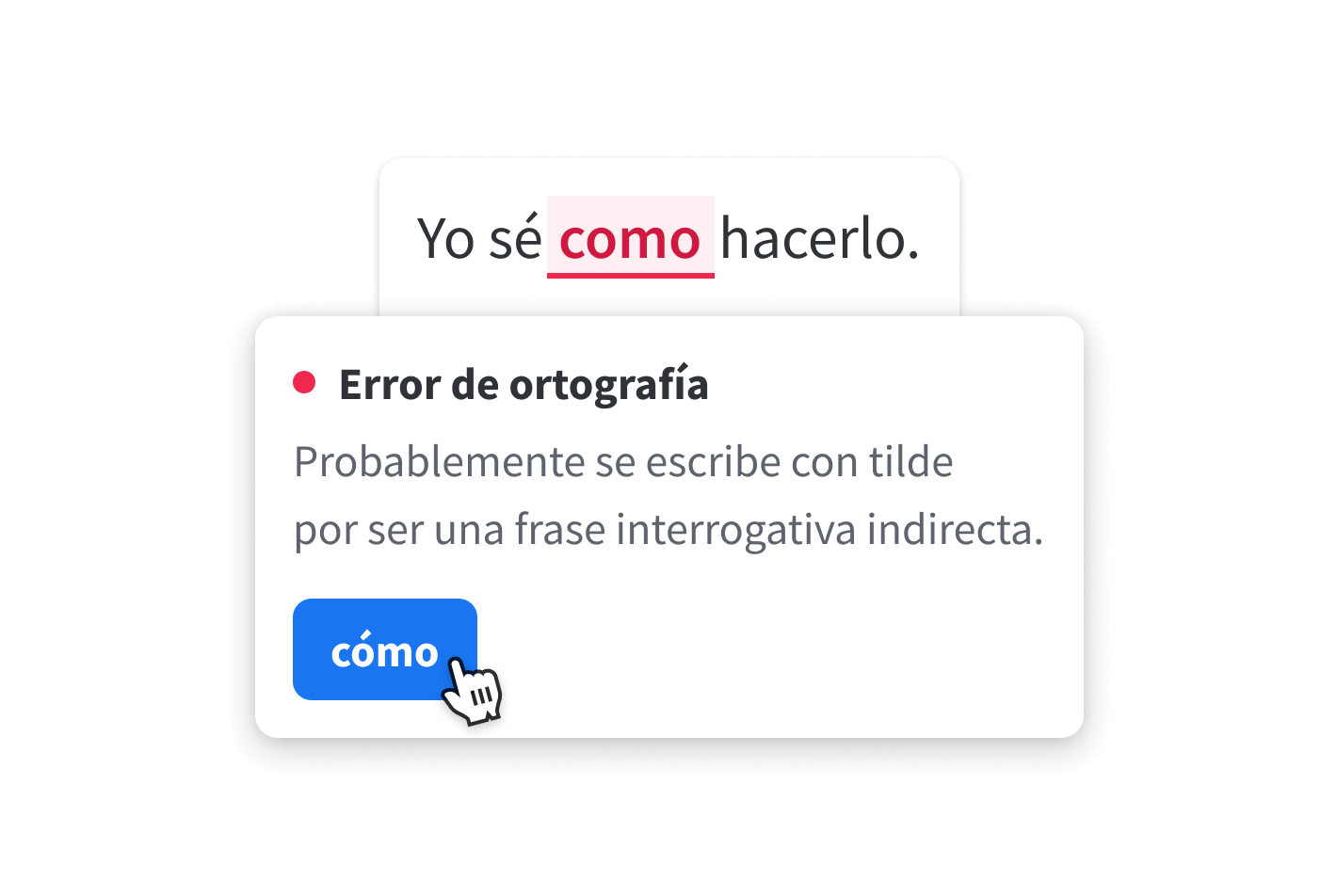
Check Grammar
Grammar rules have never been so easy! LanguageTool will help rid your writing of all grammar gaffes, like incorrect subject-verb-agreement, wrong plural forms, or misuse of grammatical forms.
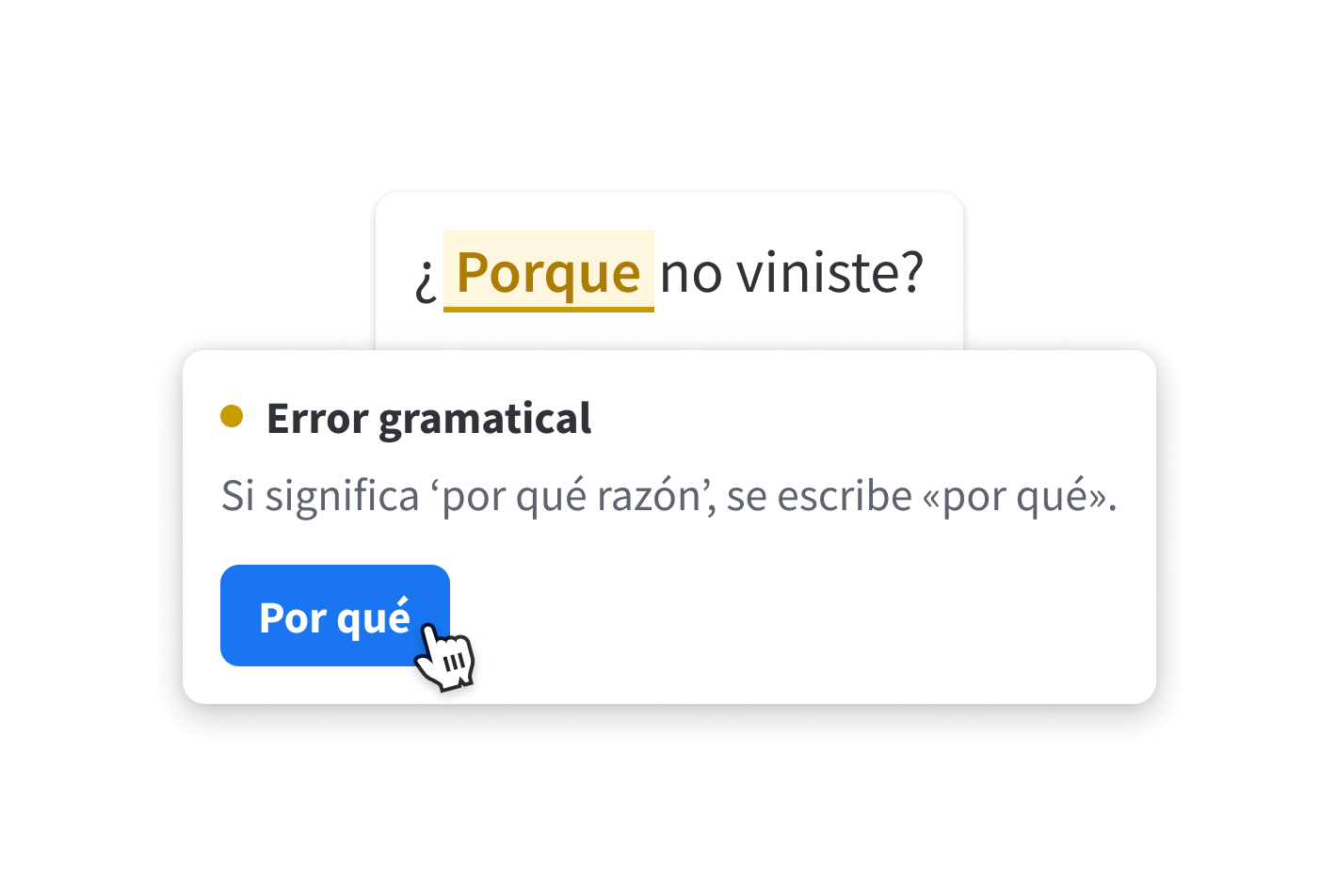
Fix Punctuation
Commas and dashes and hyphens… Proper punctuation can be tricky—LanguageTool ensures you’re using them right. It can even help you form complex sentences and tell you when you’ve used too many exclamation points!
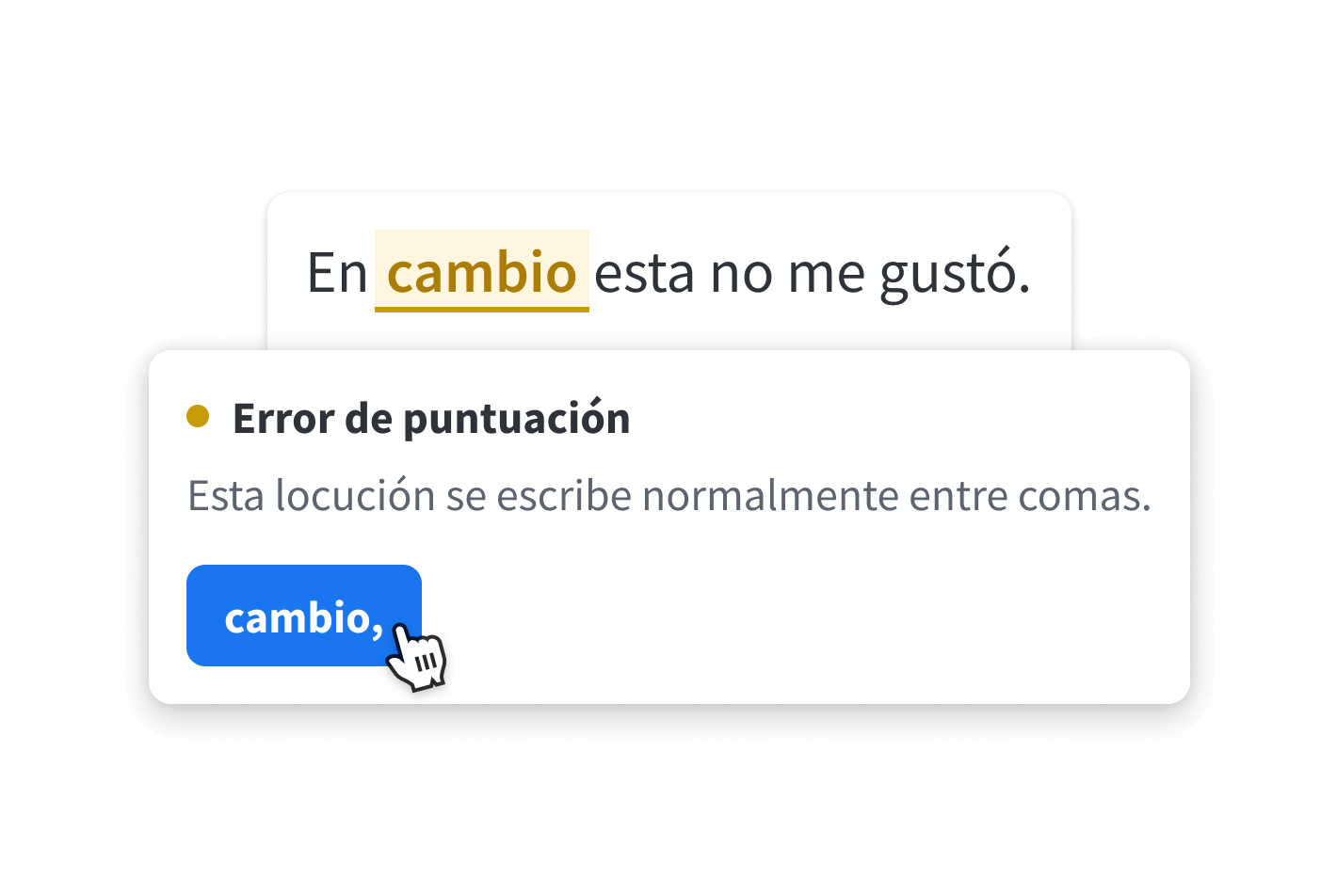
Confirm Casing
It’s all about the capital, right? And the lowercase letters, too. LanguageTool corrects incorrect casing, whether you’re writing capitalized names, months, places, or national identities.
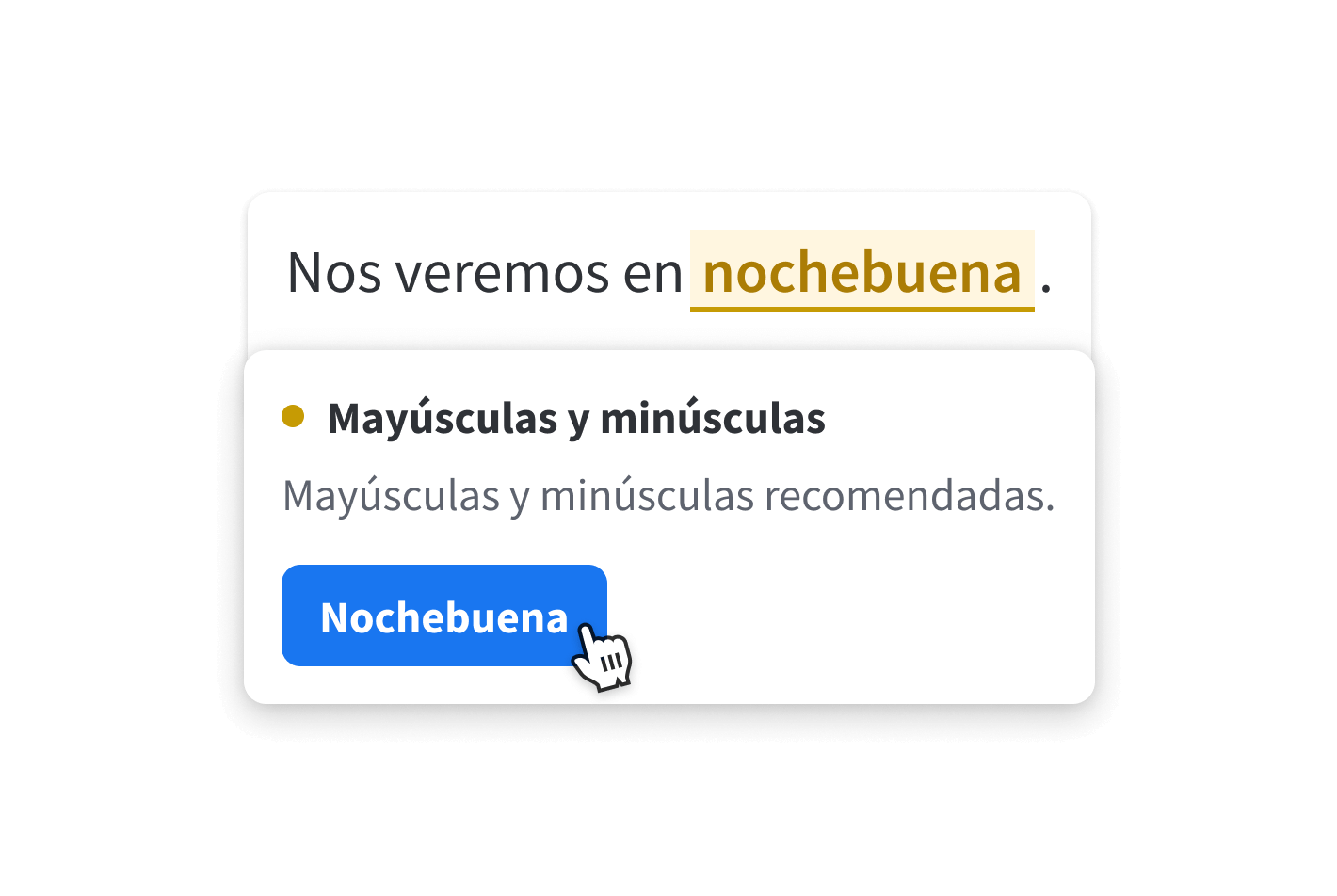
Improve Style
LanguageTool helps your writing be as stylish as you are by detecting overused phrases, foreign terms, redundant words, and improper word choice. All you have to do to find the best style is look out for the blue underline.
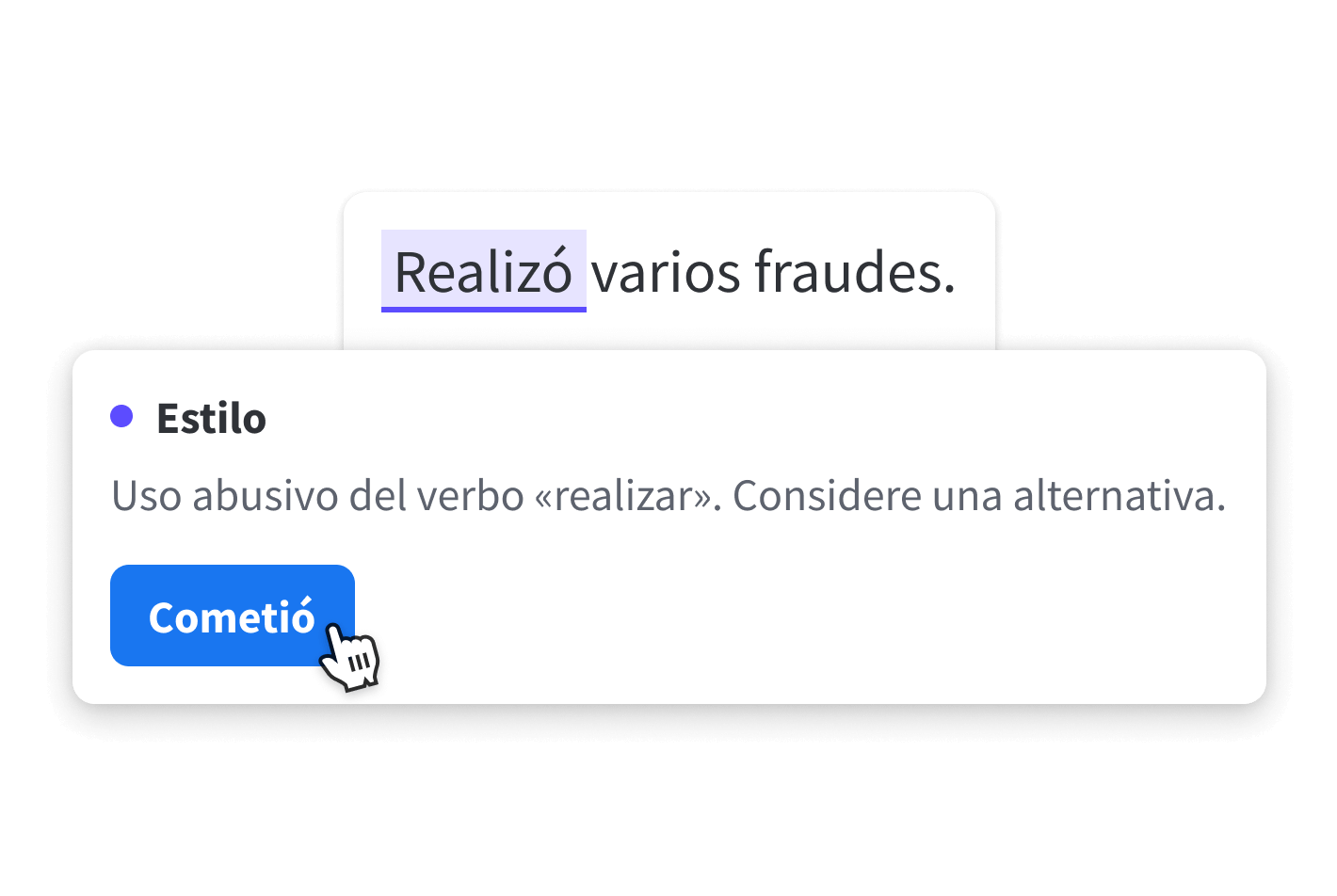
Works with all your favorite services
LanguageTool works in your browser and many other tools you use to write your texts. Install it today and get grammar as well as style suggestions wherever you write.
-
Chrome
Download
-
Edge
Download
-
Firefox
Download
-
Safari
Download
-
Word
Download
-
Google Docs
Download
-
OpenOffice
Download
-
LibreOffice
Download
-
Gmail
Download
-
Apple Mail
Download
-
Thunderbird
Download
-
Opera
Download
-
macOS
Download
-
iOS
Download
-
Editor macOS
Download
-
Editor Windows
Download
What else?
Frequently Asked Questions
Make your text sound professional and avoid embarrassing style, punctuation, and grammar mistakes
Does LanguageTool only include spelling correction?
LanguageTool corrects spelling mistakes, but it also offers a full writing analysis of all possible texts. In addition to spelling, grammar, and word choice, language style is also corrected.
How well does LanguageTool detect comma errors?
Punctuation errors of all kinds are found and corrected by LanguageTool. Its correction distinguishes between optional and required commas. Even complex sentence structures can be proofread by the comma check.
How does error detection and correction by LanguageTool work?
The error display and suggestion cards are shown automatically and directly while typing. This means that texts can be checked and corrected in just a few moments. To see synonyms, simply double-click on any word.
Read more
Which languages can be checked with LanguageTool?
LanguageTool masters more than 30 languages and dialects. Its main languages are English, Spanish, German, French, Dutch, and Portuguese. In its English version, you can choose between six standard varieties (US, UK, Canada, Australia, New Zealand, and South Africa).
Is LanguageTool free?
LanguageTool is available in two versions. The free version corrects spelling as well as simple punctuation and some style mistakes. Only the Premium version will show you all errors and give you the best possible text. Team accounts for companies are also available.
Read more
Does LanguageTool work on my program?
LanguageTool is not bound to a specific program or website. There are several extensions and add-ons available, so it can be used in all common internet browsers. In addition, you can find a dedicated text editor as an app for iOS, macOS (Apple), and Windows. All you need is just one user account.
Read more
Is LanguageTool suitable for rewriting sentences?
LanguageTool now offers an A.I.-based rephrasing function in addition to correction. This can help you to rewrite entire sentences to make them simpler, shorter, or more formal.
Read more
Can LanguageTool help me correct a bachelor or master thesis?
If you have to write a term paper, bachelor thesis or master thesis at a university, LanguageTool can help you to be sure that it is free of errors. The writing assistant’s style check is also particularly helpful for other academic texts in schools or at publishing houses. By the way, students get a discount for LanguageTool.
Read more
In this series on teaching Spanish writing skills, we’ve discussed using templates to model good writing, as well as the importance of Spanish transition words to decrease choppiness. This post will continue the writing discussion with ideas for great Spanish writing activities and Spanish writing projects to use all year long with your high school or middle school students.
Without further ado, here are some ideas:
Spanish Writing Activities (Level 1)
For level 1, I focus primarily on speaking and communication skills for at least the first half of the year before adding in a whole lot of writing. Sentences or short paragraphs are fine, but avoid long compositions until they are more confident and competent with their communication skills.
That said, here are a few shorter projects:
Postcard Project (Level 1)
Students pretend they are on vacation in a Spanish Speaking country. Pass out an index card and have students draw/print and paste photos of the scenery on one side and describe their vacation on the other.
Teach them a little bit of preterite to help them talk about where they went and what they saw. (Fui a . . ., Fuimos a, Vi, Vimos, Fue muy divertido, muy interesante, un viaje fantástico.). Don’t teach them the whole verb conjugation – only teach that “Fui a” means “I went”, “Fuimos a” means we went, “Vi” means “I saw”, “Vimos” means “We saw” and “Fue” means “It was “. Ex. I’m in Panama. There are a lot of colorful birds here. The weather is nice. Today we went to an incredible national park. We saw lots of interesting animals: iguanas, agouti, and wild parrots. Etc.
Social Media Profile
Have students write their own Facebook profile or other social media profile. They can answer questions such as: Where do you live, what do you like to do, what is your profession, etc.
Secret Valentines
Select another student’s name for each student (boys to boys, girls to boys, girls to girls) and have them write super cheesy valentines to their secret valentine. Tell them that the whole point is to write the cheesiest valentine. Students give you the valentines when they are done and you pass them out. They try to guess who their secret valentine is.
Grab your free list of Valentine’s vocab in the Free Resource Library.
JOIN THE FREE RESOURCE LIBRARY!
All about Me Writing Project
This one is great for an end-of-year project. Students describe themselves, their families, their likes and dislikes, etc. Get this free template in the Free Resource Library.
All about Me Spanish Writing Project
Spanish Writing Activities (Level 2)
Instagram Posts
Students take photos and write Instagram posts describing what they did over the summer, winter break, spring break, etc.
Personal Narrative
All about Me Project (with or without the template). See above.
Describe a Typical Day
Students describe their daily routine (great for reflexive verbs and time). If you want to add an extra fun element to this, offer extra credit if they act their days out in front of the class as funny people. Student A is behind Student B and is the arms and does all the actions while Student A talks. This is really funny as they try to brush teeth, hair, etc. Students love this activity.
Collage People
Students cut out pictures of different activities and paste them (or they can draw them) onto an outline of a person. They then write about the person that they have created, describing their likes and dislikes.
Commands
How to Project
Write instructions explaining how to make or do something (could be a recipe or a simple craft).
Create a Pamphlet
Make a pamphlet or brochure for a gym/weight loss program.
Preterite
One Crazy Family
Write about a crazy family and all the crazy things that they did all week long. Have them act out the actions in front of the class with props.
Ex. The Gonzalez family is really crazy. On Tuesday, Marta ate worms and crickets for dinner. On Friday night, Luis and Rosa rode elephants and parked them in the supermarket parking lot. What a mess!
Postcard Project (Level 2)
Students pretend they are on vacation in a Spanish Speaking country. Pass out an index card and have students draw/print and paste photos of the scenery on one side and describe their vacation on the other. Can be used with just preterite or preterite/imperfect.
Get more preterite/imperfect activities here.
Imperfect
Your Life As a Kid
Write about what your life was like when you were a kid. Students leave the name off and attach a photo from when they were little. Post them around the class with a number by each essay. Students try to guess who each person is.
Famous Person’s Life
Write about the life of a famous person.
Penpal Letters
Connect with another class in a Spanish-speaking country and have your students correspond with other students throughout the year. Collect the letter and mail them in one big envelope to save on postage (or even better, correspond via email).
Letter for Next Year
Write a letter to next year’s students telling them about your teacher and what they should expect from Spanish class.
Spanish Writing Activities (Levels 3, 4, 5)
Preterite vs. Imperfect
Class Story
Write a class story. Begin with a starter sentence like: It was a dark and stormy night. Students in class take turns adding on sentences. To get more touches with the language, divide the class into groups and let them brainstorm their own stories and then write on the board as they go. Share and correct the stories as a class afterward.
Life in the Past
Compare and contrast life today with life 50 years ago.
Photo Prompt
Use a funny photo as a writing prompt. Ex. What happened to cause this event?
Photo Writing
Show a picture with lots of things happening in it. Have students write as much as they can about the picture for 2-5 minutes.
Retell a Fairy Tale
Students write out a traditional fairy tale but change some of the details to give it a funny twist.
Change the Ending
Write the ending to a story that the class is reading before you read it.
Famous People
Students research a famous Hispanic and write a resume based on that person’s life. I like to have them add an audio-visual element to the presentation (showcasing their art, music, etc.). Get a ready-made Famous Hispanics game and project.
Movie/Book Review
Students write a review critiquing a movie or book.
Blog Post
Students write a blog post about a topic of their choosing: exercise, sports, fashion, healthy eating, etc. Have them use info. that you are studying (specific verb tenses or grammar points, transition words) in their posts.
Journal Writing
Have students write once a week in Spanish journals (either in class or at home). Be sure to tell them not to write stuff that is super personal because you will be reading it.
Journal Writing with Prompts
Give students a new prompt for each writing session. Base the prompts on the season or specific grammar points that you’re studying. Ex. (For Halloween) Describe the best Halloween costume that you ever wore. Ex. (For imperfect subjunctive) If you could change one thing about your school, what would it be?
Controversial Opinion Piece
Students present one side of a debate for a controversial topic. As the teacher, you may wish to select certain topics to choose from or you may decide to give students permission to choose (just have them check with you first before they start to write).
Future Plans
Describe what your life will be like in 10, 20, or 30 years.
Conditional
Have students answer any of the following writing prompts: 1. What would you do if you won $1,000,000? 2. What changes would you make if you were the principal of your school? 3. If you could have any special power, what would it be and why?
25 Spanish Writing Activities
End of Year Projects for Upper-Level Students
Spanish Fairy Tales
Students write and illustrate fairy tales using complex verb tenses and transition words. Give them a specific amount of transition words to use (10-15), and specific verbs (must use at least 3 conditional, 5 preterite, 5 imperfect, 3 subjunctive, etc.). Get the instructions, rubrics, and samples to show your students here.
Write a Chapter
Write an additional chapter from a book that you’ve read this year. Include elements in the style of that particular author. My favorite book is “Cuentos con sazón“. Each chapter talks about a moral problem that a kid encountered with some sort of resolution, centered around a festival in a Spanish-speaking country and involving some yummy traditional food.
Hope you found these ideas helpful and inspiring! Have a great Spanish writing project that we should all know about – let me know in the comments so I can add it to this post.
Be sure to check out the other parts of this Spanish writing series: “Using Spanish Writing Templates” and “Using Spanish Transition Words to Improve Writing“.
Helpful ready-made resources:
Grab these ready-made helpful writing resources:
101 Spanish Transition Words
Spanish Fairy Tale Project
Spanish Writing Section for an Exam
Happy Teaching!
~Sherry
World Language Cafe – French and Spanish Lesson Plans

































